PRIMARY ADVISOR:

ADVISORS:
KELLY
URBAN REWILDINGSYRACUSE U NIVERSITY S CHOOL O F ARCHITECTURE MEAGHAN
BRIAN
LONSWAY, BESS KREITEMEYER, HANNIBAL NEWSOM, JOEL KERNER
JOEL KERNER SPRING 2022 FIGURE 1 STREET-SCAPEROOF-SCAPEFACADE-SCAPE
Our planet is experiencing an unprecedented extinction event, in that is not caused by an asteroid or other natural disaster but by humans. We are losing countless species of plants and animals the and human population is rising rapidly. The United Nations predicts that human population will increase from 7.9 billion (2019) to 10.9 billion in 2100 (1) This increase in population worsens density in urban areas as well as intensifies urban sprawl. There has been an upward trend of humans moving from rural to urban areas in the last 10 years and mega-cities are on the rise. This rapid increase in human population has not and is not predicted to bode well for ever shrinking animal habitat. This lack of habitat and greenery hurts humans as well as animals. Availability of green space and nature improves statistics on violent crime, helps with mental health, improves air quality and combats climate change.
If cities are expected to expand and grow, how can cities reintegrate vital animal habitat back into the fabric of the city? Some cities have been successful in passing legislation that makes maintaining habitat and integrating greenery into new buildings a requirement. The Singapore Green Plan for 2030 sets goals for the city in terms of reducing waste, creating new green spaces, improving public transit, lowering reliance on diesel cars and producing food locally. (2) These methods are proving to be successful in creating a sustainable “garden city”. What is there to learn from leg islation like this? And how can it be applied to cities with similar densities.
Is it possible for Manhattan to become a “garden city”. The area of Manhattan used to rival Yellowstone national park in terms of biodi versity in the 1600s. Before it became a concrete jungle it was home to Grey wolves, bears, harbor porpoises amongst thousands of other species of plants and animals. Prior to Dutch settlement in 1609 it was known as “Manahhat ta” or in English “island of many hills” by the native Lenape people. Now there is zero intact original habitat in Manhattan although some species have survived over 400 years of urbanization. (3)



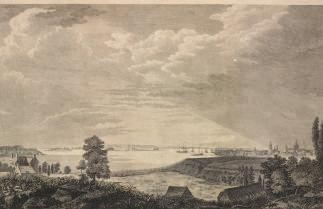
Manhattan presents a good opportunity for habitat reintroduction and reintegration in
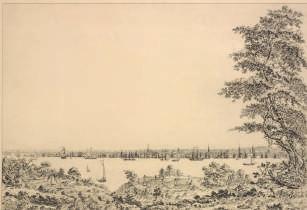

that it may soon offer up massive amounts of space for redevelopment with the current and projected movement away from the use of private cars. The 23 square miles of Manhattan is covered in spaces designated to car use from street parking, garages and multilevel parking structures. If you add up all these spaces you are left with an area four times as large as central park. There are already several proposals to ban cars in Manhattan including placing tolls on cars south of 60th street, which was delayed due to the pandemic, and completely banning cars from fourteenth street. It seems odd to designate so much space for cars when more than half of its population does not own a car. In terms of those who do not live in Manhattan and commute in, more than 88 percent use public transportation.(4) Many people want to take this space and give it back to the citizens of New York. But what if it is given back to the non-human citizens as well, existing and prior animal and plant residents. Where can habitat fit into the street-scape, parking structures and bridges in order or allow humans as well as plant and animal species to travel through the island. This allows for safer, cleaner, human travel as well as a way for animals to move from habitat core to core. In GIS mapping done by the Living Atlas habitat cores are currently being connected around the borders of Manhattan and not through it.(5) Re-wilded streets-capes allow for a system of travel for species to move thats been missing for centuries.
Walking out of your walk up or luxury condo and into a world of people traveling not by car but by bike, train, bus or walking will hopefully lead to a new investment in preserv ing landscapes that still exist and remain intact. How can you truly invest in and care about something that you have never see with your own eyes.
ABSTRACT
1.“Population,” United Nations (United Nations), accessed May 12, 2022, https://www. un.org/en/global-issues/population, 1. 2.“Singapore Green Plan 2030,” Singapore Green Plan 2030, accessed May 12, 2022, https://www.greenplan.gov.sg/, 1. 3.“Explore the Lush, Overgrown Ecology of 1600s Manhattan,” Bloomberg. com (Bloomberg), accessed May 23, 2022, https://www.bloomberg.com/news/articles/2015-10-01/mapping-the-wildlife-and-peoples-of-manhattan-in-1609, 2. 4.“Open Streets,” NYC DOT - Open Streets, accessed May 23, 2022, https://www1.nyc. gov/html/dot/html/pedestrians/openstreets.shtml, 2. 5.“Intact Habitat Cores by Connectivity Importance,” Arcgis.com, accessed May 23, 2022, https://www.arcgis.com/home/item.html?id=fe42b11c901d4dbab8833c2415ed21b7, 3. 23
The British Headquarters Map, circa 1782, is the best record of Mannahatta’s early topography and ecology. The National Archives of the UK, ref. MR1/463. figure 1
John Randel’s grid plan for Manhattan, mapped in 1811. The New York Public Library figure 3
figure 2
SITUATION
Illustrations of NYC habiat prior to industrialization The Miriam and Ira D. Wallach Division of Art, Prints and Photographs: Print Collection, The New York Public Library. “New York in 1776, from the rear of Col. Rutger’s house, East River ; engr[raved] by W. G. Jackman.” New York Public Library Digital Collections. Accessed March 23, 2022. https://digitalcollections.nypl.org/items/5e66b3e8-
THESIS
MAIN
How can we as architects facilitate a better understanding of and relationship to the natural world for city dwellers specifically?
As urban sprawl worsens and cities expand more and more people reside in cities rather than in rural areas. This causes human to ecosystem relationships to further fracture.
Worsening urban sprawl is destroying valuable habitat for endangered species in addition to further separating city dwellers from fostering relationships with valuable species and ecosystems.
Where can species and micro ecosystems be worked back into the fabric of large sprawling cities like New York City?
The projected lower reliance on cars as the primary means of transportation in densely populated cities like New York City opens up large swathes of land for ecosystem redevelopment. Imagine walking out of your apartment on your way to the train or bus into a system of boardwalks and micro wetlands and being able to hear birds chirping and see small mammals running beneath your path.
In addition to the street-scape architectural elements like a facade or roof could be re-appropriated as habitat. How can a facade panel shed water as well as house a bat or a beetle?
Although re-wilding can be though of as a movement to recreate the past it can also be seen as a reintegration of valuable species in a controlled way. How do we determine which species to bring back. There are many species known for their ability to provide ecosystem services. Bats, bees, beetles and butterflies are pollinators and small felines and birds of prey provide pest control.
We can not completely re-wild Manhattan to the forests of 1609 but we can locate and redesign and architectural components to work dually as habitat while still providing their human functions.
QUESTIONS
4 5
REWILDING


TERMINOLOGY
MATERIAL EXPERIENCE
FERAL ECOLOGIES



POSITION

INVERTIBRATES
As architects, we are operating in a landscape of shifting ecological and cultural values. We must not only develop strategies for incorporating diverse habitats into the spatial and built environment, but we must also take on the challenge to radically rethink the spatial and visible dimensions of animals and urban organisms. In the process of doing so, we will not only enable urban citizens to envision the possibilities of living among ‘pests,’ we’ll also unshackle architecture from some of its time-loaded assumptions and cultural biases. It is only then that architecture can become a vehicle for provoking new priorities, rather than simply responding to them. Here are some issues for architects to consider as we proceed into an emerging bio-synthetic world.

-Joyce Hwang of Ants of the Prairie
Living Among Pests Originally published in Volume #35: Everything Under Control

PIONEERS IN THE FE I LD BATS
SMALL STRUCTURES
TRAILS Images sourced from https://soa.syr.edu/ lectures/ 6 7
ACKOWLEDGEMENTS
1. Design and the Biodiverse: Kristina Hill Kristina Hill Program Director of IURD and Associate Professor of Landscape Architecture & Environmental Planning and Urban Design, College of Environmental Design; University of California, Berkeley
FROM SPECIES TO SYSTEM: BIODIVERSITY IS ON FIRE
2. Design and the Biodiverse: Joyce Hwang Joyce Hwang Associate Professor and Director of Graduate Studies, Department of Architecture; University of Buffalo
3. Design and the Biodiverse: Gena Wirth Gena Wirth Design Principal, SCAPE DESIGN FOR INVERTEBRATES
4. Design and the Biodiverse: Nina-Marie Lister Nina-Marie Lister Professor and Graduate Director, School of Urban + Regional Planning; Ryerson University Director, Ecological Design Lab; Ryerson University Founding Principal, PLANDFORM DESIGN FOR DIVERSITY: BETWIXT CULTURE AND NATURE AND THE WILD BETWEEN
5. Design and the Biodiverse: Erin Moore Erin Moore Professor of Architecture and Environmental Studies; University of Oregon SPATIAL PRACTICE FOR AN INSEPARABLE WHOLE: DESIGN, RESISTANCE, AND BIODIVERSITY
6. Design and the Biodiverse: Richard Weller Richard Weller
Meyerson Chair of Urbanism and Professor and Chair of Landscape Architecture, Executive Director of the McHarg Center; Weitzman School of Design, University of Pennsylvania
If someone were to replicate my thesis either in an academic or a professional forum I would hope that they would be able to first recognize that urban sprawl and an increasing population density in cities is leading to a disconnect between city dwellers and ecosystems. We desperately need legislators, politicians and young people to reinvest in the species and ecosystems that are quickly disappearing from the urban fabric?
Where are the architectural in between spaces that can be filled with built habitat. How can proximity, immersion and representation be used to foster this re invigorated interest in re-wilding our built landscape.
TABLE OF CONTENTS
-
89
1.LIST OF MEDIA SECTION Pages 10-11 2.MAIN BODY Pages 12-35 3.RESEARCH METHODOLOGY Pages 14-15 4.AUDIENCE Pages 32-33 5.DESIGN OUTCOMES SECTION Pages 36-37 6.DESIGN METHODOL
OGY Pages 40-41 7.FOCUS SPECIES Pages 42-43 8.ROOFSCAPE Pages 44-53 9.FACADESCAPE SECTION Pages 54-57 10.STREET -SCAPE Pages 58-61 11.WORKS CITED AND FOR FURTHER READING Pages 62-69
LIST OF MEDIA
FIGURE 1 : The British Headquarters Map, circa 1782, is the best record of Mannahatta’s early topography and ecology. The National Archives of the UK, ref. MR1/463.
FIGURE 2: The Miriam and Ira D. Wallach Division of Art, Prints and Photographs: Print Collection, The New York Public Library. “New York in 1776, from the rear of Col. Rutger’s house, East River ; engr[raved] by W. G. Jackman.” New York Public Library Digital Collections. Accessed March 23, 2022. https://digitalcollections.nypl.org/items/5e66b3e8-de08-d471-e040-e00a180654d7
FIGURE 3: The Miriam and Ira D. Wallach Division of Art, Prints and Photographs: Print Collection, The New York Public Library. “This map of the city of New York and island of Manhattan....” New York Public Library Digital Collections. Accessed May 12, 2022. https://digitalcollections.nypl.org/items/510d47d97a92-a3d9-e040-e00a18064a99
FIGURE 4,5,6: Arcgis.com. Accessed May 12, 2022. https://www.arcgis.com/home/item.html?id=0d2f35395c3c43ecb7685df9be63dd84. (Green Infrastructure Center Inc., Esri)
FIGURE 7: The Welikia (“Way-LEE-Kee-Uh”) Project. Accessed May 12, 2022. https://welikia.org/.Google Maps. Google. Accessed May 12, 2022. https://www.google.com/maps/place/Manhattan,+New+York,+NY/@40.7591704,-74.0392706,27789m/ data=!3m1!1e3!4m5!3m4!1s0x89c2588f046ee661:0xa0b3281fcecc08c!8m2!3d40.7830603!4d-73.9712488.
FIGURE 8: Arcgis.com. Accessed May 12, 2022. https://www.arcgis.com/home/item.html?id=7a846ea386cb40ce8527137cdf525b09. Green Infrastructure Center Inc., Esri
FIGURE 9: Arcgis.com. Accessed May 12, 2022. https://www.arcgis.com/home/item.html?id=f8352a73777b4f23800cbd4cf83bcc72.Green Infrastructure Center Inc., Esri
FIGURE 10: Arcgis.com. Accessed May 12, 20222. Green Infrastructure Center Inc., Esri, https://www.arcgis.com/home/item.html?id=f8352a73777b4f23800cbd4cf83bcc72
FIGURE 11: Welikia 1609 map. Accessed May 12, 2022. https://welikia.org/m-map.php.
FIGURE 12: Welikia 1609 map. Accessed May 12, 2022. https://welikia.org/m-map.php.
FIGURE 13, 14: World Park Project. Accessed May 12, 2022. https://theworldpark.com/.(Concept: Richard Weller,Graphic design by Madeleine Ghillany-Lehar)
FIGURE 15: Arcgis.com. Accessed May 12, 2022. https://www.arcgis.com/home/item.html?id=7a846ea386cb40ce8527137cdf525b09. Green Infrastructure Center Inc., Esri
FIGURE 16: Streetscape Sketches, Meaghan Kelly, “Urban Rewilding” (Syracuse University 2022).
FIGURE 17: “Hotspot Cities.” AFEW - Hotspot Cities. Accessed May 12, 2022. http://atlas-for-the-end-ofthe-world.com/hotspot_cities_main.html.
FIGURE 18: Arcgis.com. Accessed May 12, 2022. https://www.arcgis.com/home/item.html?id=0d2f35395c3c43ecb7685df9be63dd84.
FIGURE 19: Arcgis.com. Accessed May 12, 2022. https://www.arcgis.com/home/item.html?id=0d2f35395c3c43ecb7685df9be63dd84.
FIGURE 20 : Parking diagrams, Meaghan Kelly, “Urban Rewilding” (Syracuse University 2022).
FIGURE 21: Parking diagrams of the Streetscape, Meaghan Kelly, “Urban Rewilding” (Syracuse University 2022).
FIGURE 22: Initial Concept Sketch, Meaghan Kelly, “Urban Rewilding” (Syracuse University 2022).
FIGURE 23: Design scope Sketch, Meaghan Kelly, “Urban Rewilding” (Syracuse University 2022).
FIGURE 24: Pollinator and Pest Predator Diagram, Meaghan Kelly, “Urban Rewilding” (Syracuse University 2022).
FIGURE 25: Roof Life Cycle Analysis Diagram, Meaghan Kelly, “Urban Rewilding” (Syracuse University 2022).
FIGURE 26: Roof Axon Drawing, Meaghan Kelly, “Urban Rewilding” (Syracuse University 2022).
FIGURE 27: Roof Axon Use Diagram, Meaghan Kelly, “Urban Rewilding” (Syracuse University 2022).
FIGURE 28: Site Plan, Elevation, Food chain Diagram Meaghan Kelly, “Urban Rewilding” (Syracuse University 2022).
FIGURE 29: Site axons Diagram Meaghan Kelly, “Urban Rewilding” (Syracuse University 2022).
FIGURE 30: Facade Life Cycle Analysis, Meaghan Kelly, “Urban Rewilding” (Syracuse University 2022).
FIGURE 31: Facade Full Section, Meaghan Kelly, “Urban Rewilding” (Syracuse University 2022). 2022).
FIGURE 32: Current and Proposed street Diagrams, Meaghan Kelly, “Urban Rewilding” (Syracuse University 2022).
FIGURE 33: Animal Travel Section, Meaghan Kelly, “Urban Rewilding” (Syracuse University 2022).
FIGURE 34: Re-wilded street scape sketches, Meaghan Kelly, “Urban Rewilding” (Syracuse University 2022).
FIGURE 35: Street full section sketches, Meaghan Kelly, “Urban Rewilding” (Syracuse University 2022).
10 11
SECTION 1 - MAIN BODY - RESEARCH
MEAGHAN KELLY
CONTEXT - CASE STUDIES
PRIMARY ADVISOR: JOEL KERNER
12 13
Choose issue and clearly define it: Loss of species diversity in cites
Determine possible design solutions : urban re-wilding
Based on research on cities with urban sprawl and species loss determine focus city: Manhattan
Determine which cities are successful in urban re-wilding to research means of successful re-wilding: Singapore
Determine focus species based on research of pollinators and pest predators and their benefits to the city.
Research the specific dietary and habitat needs of chosen focus species
Define scope based on the scapes of street, facade and roof
DESIGN
Based on species research design habitat within scapes
DESIGN
RESEARCH METHODOLOGY 1 2 3 4 5 6 14 15
WHAT IS URBAN REWILDING?
WHAT IS REWILDING?
RESTORATIONVS REWILDING
According to Nina-Marie Lister: “Design for
Culture and Nature and the Wild Between”
-Management focused
Returns to idealized ecosystems Reset/ fixed (implies bro-ken)
preservation -Colonial/ American preser-vation
in time, where? Implies baseline conditions
Native Species, no invasives
-Stewardship Initiated
Reorganizes, regenerates degraded ecosystems
Reintegrate beyond just with human
embraces change Post colonial, Euro centric
ended
shifting
“Rewilding, or re-wilding, activities are conservation efforts aimed at restoring and protecting natural processes and wilderness areas. This may include providing connectivity between such areas, and protecting or reintroducing apex predators and keystone species.”
Syracuse
True Nature Foundation True Nature Foundation, 2022, https://truenaturefoundation.org/what-is-rewilding/.
1617
-Status
-Bounded
Diversity: Betwixt
Recognizes/
-Open-
-Accepts
baseline -Feral, novel, hybrid
Architecture, accessed May 12, 2022, https://soa.syr.edu/ live/events/1070-design-and-the-biodiverse-nina-marie-lister.
MANHATTAN HABITAT
VALUABLE INTACT HABITAT SURROUNDING MANHATTEN


What was the ecosystem?


An ecosystem is a geographic area where plants, animals, and other organisms, as well as weather and landscapes, work together to form a bubble of life.
National Geographic Society, 2012, https://www.nationalgeographic.org/encyclopedia/ecosystem/.

Although there is little left to remember its past the biodiversity of Manhattan once rivaled that of Yellowstone National park, Yosemite and the great Smoky mountains with 55 distinct ecological communities.
Manhattan is something like one percent the size of Yellowstone. Yellowstone is 2.2 million acres and it has 66 ecosystems. Mannahatta had 55.
The Welikia (“Way-LEE-Kee-Uh”) Project, accessed May 12, 2022, https://welikia.org/ about/overview/.
figure 4, 5, 6 :
This layer represents modeled Intact Habitat Cores, or minimally disturbed natural areas. It was created as part of Esri’s Green Infrastructure Initiative and is one of five companion layers that can be used for Green Infrastructure Planning. (Green Infrastructure Center Inc., Esri)
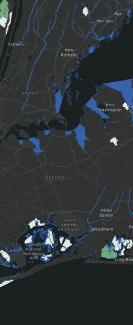

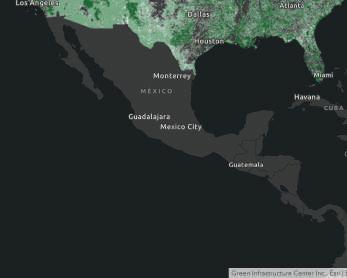

“coastal oak-pine forest” and “red maple swamps.”
MANHATTAN HAS NO REMAINING ORGINAL HABITAT
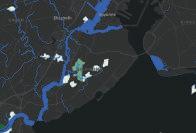
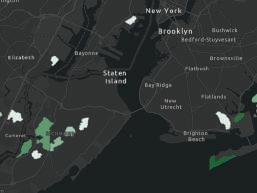

Prior to 1609 Present figure 7
On the left a rendering of 1609 Manhattan from the welika project and on the right a google maps image from present day The Welikia (“WayLEE-Kee-Uh”) Project. Accessed May 12, 2022. https://welikia.org/.



intact habitat coresUSA
megalopolis
figure 4
figure 5 figure 6
18 19
SPECIES
SPECIES RICHNESS




figure 8



There is no habitat left in Manhatten but the areas surrounding it in New Jersey, Delaware and Long Island maintain habitat and a species richness.



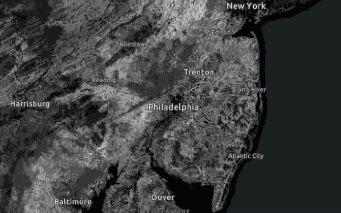



HABITAT
Least cost paths connecting habitat cores


there are no connections moving through Manhattan preventing species travel from habitat to habitat eastern us habitat connectors



The two left side maps show Species richness from living atlas esri gis database at three different scales NatureServe Network. April 2021. The Map of Biodiversity Importance. Arlington, VA. U.S.A. After fi ve years of research The Welika Project determines it is likely that “1000 species of plants and vertebrate animals (24 species of mammals, 233 birds, 32 reptiles and amphibians, 85 fish, and 627 species of plants, and unknown numbers of fungi, lichens,
how can connections be made through Manhattan from one habitat connector to connector




“This layer represents modeled Least Cost Paths (LCPs) among neighboring Intact Habitat Cores. It was created as part of Esri’s Green Infrastructure Initiative and is one of five companion layers that can be used for Green Infrastructure Planning.” -https://www.arcgis.com/home/item. html?id=f8352a73777b4f23800cbd4cf83bcc72





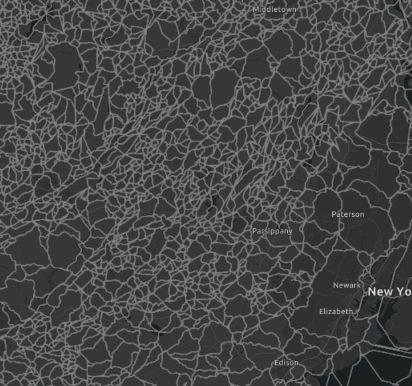
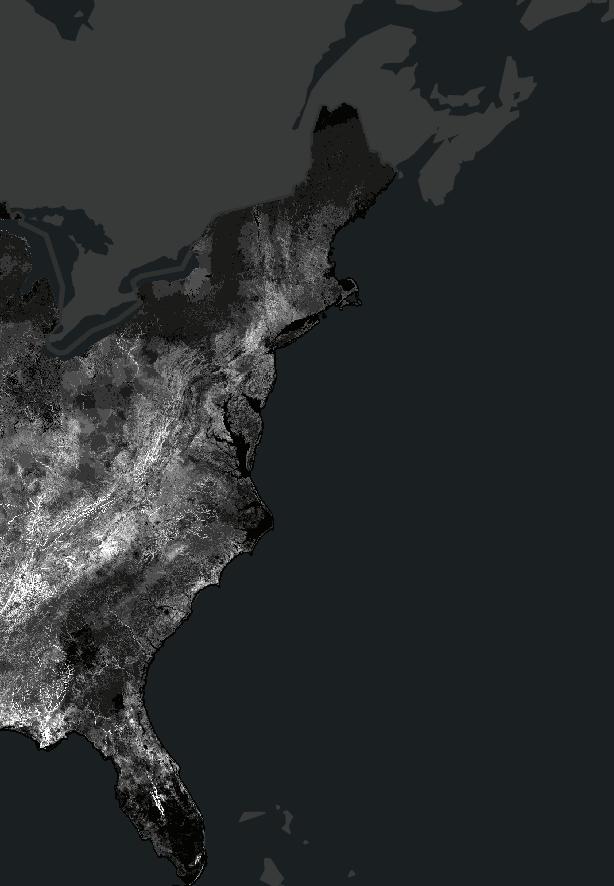


21
RICHNESS CONNECTING
SPECIES RICHNESS
mosses, insects, shellfish sh and other invertebrates) once occurred on Mannahatta. These likely wildlife includedwolves,blackbears,mountainlions,beavers,passengerpigeons,heathhens,timber rattlesnakes, tree frogs, bog turtles and over 30 species 20 of orchids and 70 species of trees.” The Welikia (“Way-LEE-Kee-Uh”) Project, accessed May 12, 2022, https://welikia.org/. figure 10 “This layer represents modeled Least Cost Paths (LCPs) among neighboring Intact Habitat Cores. It was created as part of Esri’s Green Infrastructure Initiative and is one of five companion layers that can be used for Green Infrastructure Planning.” Green Infrastructure Center Inc., Esri, https://www.arcgis.com/home/item.html?id=f8352a73777b4f23800cbd4cf83bcc72 figure 9
MAMMALS


Common Name -Scientific Name
Meadow Vole Microtus pennsylvanicus
White-footed Mouse
AMPHIBIANS
Common Name -Scientific Name
Common Name Scientific Name
Peromyscus leucopus
Deer Mouse - Peromyscus maniculatus
Southern Flying Squirrel Glaucomys volans
Eastern Gray Squirrel Sciurus carolinensis
Eastern Cottontail Sylvilagus floridanus
Raccoon Procyon lotor
Masked Shrew Sorex cinereus
Eastern Chipmunk Tamias striatus
Striped Skunk Mephitis mephitis
Big Brown Bat Eptesicus fuscus
Red Bat Lasiurus borealis
Hoary Bat Lasiurus cinereus
Silver-haired Bat Lasionycteris noctivagans
Gray Wolf Canis lupus
Bobcat Lynx rufus
Mountain Lion uma concolor
Gray Fox Urocyon cinereoargenteus
American Black Bear Ursus americanus
Dog-Canis lupus familiaris
White-tailed Deer Odocoileus virginianus
BIRDS
Common Name Scientific Name
Sharp-shinned Hawk Accipiter striatus
Red-tailed Hawk Buteo jamaicensis
Broad-winged Hawk Buteo platypterus
Northern Flicker Colaptes auratus
American Crow Corvus brachyrhynchos
Common Raven Corvus corax
Passenger Pigeon Ectopistes migratorius
Black-capped Chickadee Poecile atricapillus
Brown Thrasher Toxostoma rufum
American Robin Turdus migratorius
Cedar Waxwing Bombycilla cedrorum
Ruffed Grouse Bonasa umbellus
Canada Warbler Cardellina canadensis
Purple Finch Carpodacus purpureus
American Kestrel Falco sparverius
Baltimore Oriole Icterus galbula
Black-and-white Warbler Mniotilta varia
Rose-breasted Grosbeak Pheucticus ludovicianus
Downy Woodpecker Picoides pubescens
Bay-breasted Warbler Setophaga castanea
Blackpoll Warbler Setophaga striata
White-breasted Nuthatch Sitta carolinensis
House Wren Troglodytes aedon
Red-eyed Vireo Vireo olivaceus
Mourning Dove Zenaida macroura
Wild Turkey Meleagris gallopavo
Song Sparrow Melospiza melodia
Eastern Towhee Pipilo erythrophthalmus
Blue Jay Cyanocitta cristata
Long-billed Curlew Numenius americanus
Eskimo Curlew Numenius borealis
Great Horned Owl Bubo virginianus
Veery Catharus fuscescens
American Woodcock Scolopax minor Swainson’s Thrush Catharus ustulatus
Ruby-throated Hummingbird Archilochus colubris
Red-shouldered Hawk Buteo lineatus
Wilson’s Warbler Cardellina pusilla
Hermit Thrush Catharus guttatus
Olive-sided Flycatcher Contopus cooperi
Red-bellied Woodpecker Melanerpes carolinus
Indigo Bunting Passerina cyanea
Black-throated Blue Warbler Setophaga caerulescens
Magnolia Warbler Setophaga magnolia
Black-throated Green Warbler Setophaga virens
Common Yellowthroat Geothlypis trichas
Eastern Kingbird Tyrannus tyrannus
Great Crested Flycatcher Myiarchus crinitus
Hairy Woodpecker Picoides villosus
American Redstart Setophaga ruticilla
Yellow-bellied Flycatcher Empidonax flaviventris
Nashville Warbler Leiothlypis ruficapilla
Ovenbird Seiurus aurocapilla
Warbling Vireo Vireo gilvus
Scarlet Tanager Piranga olivacea
Northern Saw-whet Owl Aegolius acadicus
Field Sparrow Spizella pusilla
REPTILES
Common Name Scientific Name Probability
Snapping Turtle Chelydra serpentina
Brown Snake Storeria dekayi
Eastern Milk Snake Lampropeltis triangulum
Eastern Worm Snake Carphophis amoenus
Spotted Turtle Clemmys guttata
Eastern Mud Turtle Kinosternon subrubrum
Eastern Box Turtle Terrapene carolina
Northern Black Racer Coluber constrictor
Northern Ringneck Snake Diadophis punctatus
Timber Rattlesnake Crotalus horridus
Northern Water Snake Nerodia sipedon
Eastern Ribbon Snake Thamnophis sauritus
Green Frog Rana clamitans
Two Lined Salamander Eurycea bislineata
Red Spotted Newt Notophthalmus viridescens
Eastern Spadefoot Toad Scaphiopus holbrookii
Spring Peeper Pseudacris crucifer
Spotted Salamander Ambystoma maculatum
Fowler’s Toad Bufo fowleri
Northern Gray Treefrog Hyla versicolor
Southern Leopard Frog Rana sphenocephala
Wood Frog Rana sylvatica
Blue Spotted Salamander Complex Ambystoma laterale Marbled Salamander Ambystoma opacum
FISH
Common Name Scientific Name
Crevalle jack Caranx hippos
Atlantic silverside Menidia menidia
Atlantic tomcod Microgadus tomcod
Ninespine stickleback Pungitius pungitius Porgy (Scup) Stenotomus chrysops
Atlantic needlefish Strongylura marina Red hake Urophycis chuss
Fourspot flounder Hippoglossina oblonga Atlantic rainbow smelt Osmerus mordax
Winter flounder Pseudopleuronectes americanus
Atlantic sturgeon Acipenser oxyrinchus Hickory shad Alosa mediocris
American shad Alosa sapidissima
Fourspine stickleback Apeltes quadracus Conger eel Conger oceanicus
Weakfish Cynoscion regalis
Atlantic cod Gadus morhua
Spot Leiostomus xanthurus
Little skate Leucoraja erinacea
Striped bass Morone saxatilis
Striped mullet Mugil cephalus Longhorn sculpin Myoxocephalus octodecemspinosus
Striped cusk-eel Ophidion marginatum Summer flounder Paralichthys dentatus
Sea lamprey Petromyzon marinus Rock gunnel holis gunnellus
Windowpane Scophthalmus aquosus
Northern puffer Sphoeroides maculatus
Spiny dogfish Squalus acanthias
Hogchoker Trinectes maculatus
Alewife Alosa pseudoharengus
Black sea bass Centropristis striata
Lined seahorse Hippocampus erectus
Oyster toadfish Opsanus tau
White mullet Mugil curema
Atlantic mackeral Scomber scombrus
Threespine stickleback Gasterosteus aculeatus
Striped searobin Prionotus evolans
Atlantic menhaden Brevoortia tyrannus
Naked goby Gobiosoma bosc
Tautog Tautoga onitis
Atlantic herring Clupea harengus
Cunner Tautogolabrus adspersus Bay anchovy Anchoa mitchilli
Silver perch Bairdiella chrysoura
Spotfin killifish Fundulus luciae
Sea raven Hemitripterus americanus
Inland silverside Menidia beryllina
Black drum Pogonias cromis
Grubby Myoxocephalus aenaeus
Pigfish Orthopristis chrysoptera
Northern kingfish Menticirrhus saxatilis
Spotted hake Urophycis regia
American sand lance Ammodytes americanus
Round herring Etrumeus teres
Sheepshead Archosargus probatocephalus
Rough silverside Membras martinica
Striped anchovy Anchoa hepsetus
ANIMAL SPECIES CATALOGUE
PLANTS
Common Name Scientific Name
Virginia threeseed mercury Acalypha virginica L. red maple Acer rubrum L. American hornbeam Carpinus caroliniana Walt. starved panicgrass Dichanthelium depauperatum (Muhl.)Gould prairie fleabane Erigeron strigosus Muhl.exWilld. Virginia creeper Parthenocissus quinquefolia (L.)Planch.
black cherry Prunus serotina Ehrh. roundleaf greenbrier Smilax rotundifolia L. blackhaw Viburnum prunifolium L. American chestnut Castanea dentata (Marsh.)Borkh. white wood aster Eurybia divaricata (L.)Nesom northern red oak Quercus rubra L. flameleaf sumac Rhus copallinum L. mapleleaf viburnum Viburnum acerifolium L. nimblewill
Muhlenbergia schreberi J.F.Gmel. smooth rockcress Arabis laevigata (Muhl.exWilld.)Poir.
wild sarsaparilla Aralia nudicaulis L. butterfly milkweed Asclepias tuberosa L. smooth yellow false foxglove Aureolaria flava (L.)Farw. parasol sedge Carex umbellata SchkuhrexWilld. striped prince’s pine Chimaphila maculata (L.)Pursh scaldweed Cuscuta gronovii Willd.exJ.A.Schultes
nakedflower ticktrefoil Desmodium nudiflorum (L.)DC. prostrate ticktrefoil Desmodium rotundifolium DC. marginal woodfern Dryopteris marginalis (L.)Gray American burnweed Erechtites hieraciifolius (L.) Raf. ex DC. red fescue Festuca rubra L. Virginia strawberry Fragaria virginiana Duchesne licorice bedstraw Galium circaezans Michx. fragrant bedstraw Galium triflorum Michx. black huckleberry Gaylussacia baccata (Wangenh.)K.Koch spotted geranium Geranium maculatum L. cream avens Geum virginianum L. American witchhazel Hamamelis virginiana L. eastern redcedar Juniperus virginiana L. mountain laurel Kalmia latifolia L. trailing lespedeza Lespedeza procumbens Michx. woodland flax Linum virginianum L. trumpet honeysuckle Lonicera sempervirens L. feathery false lily of the vally Maianthemum racemosum (L.)Link partridgeberry Mitchella repens L. rock muhly Muhlenbergia sobolifera (Muhl.exWilld.)Trin.
common evening-primrose Oenothera biennis L. switchgrass Panicum virgatum L. broad beechfern Phegopteris hexagonoptera (Michx.)Fée
American lopseed Phryma leptostachya L. clammy groundcherry Physalis heterophylla Nees pitch pine Pinus rigida P.Mill. climbing false buckwheat Polygonum scandens L. Christmas fern Polystichum acrostichoides (Michx.)Schott
Norwegian cinquefoil Potentilla norvegica L. black oak Quercus velutina Lam. Carolina rose Rosa carolina L. Pennsylvania catchfly Silene caroliniana Walt.ssp.pensylvanica(-Michx.)Clausen wreath goldenrod Solidago caesia L. clasping Venus’ looking-glass Triodanis perfoliata (L.)Nieuwl. highbush blueberry Vaccinium corymbosum L. early blue violet Viola palmata L. fox grape Vitis labrusca L. pignut hickory Carya glabra (P.Mill.)Sweet roundlobe hepatica Hepatica nobilis Schreb.var.obtusa(Pursh)
Steyermark white baneberry Actaea pachypoda Ell. Jack in the pulpit Arisaema triphyllum (L.)Schott spear saltbush Atriplex patula L. alternateleaf dogwood Cornus alternifolia L.f. Tuliptree Liriodendron Tulipifera Virginia mountainmint Pycnanthemum virginianum (L.)T.Dur.&B.D.JacksonexB.L.Robins.&Fern. smooth blackberry Rubus canadensis L. forked bluecurls Trichostema dichotomum L. slimspike threeawn Aristida longispica Poir. white vervain Verbena urticifolia L. Allegheny hawkweed Hieracium paniculatum L. whorled milkwort Polygala verticillata L. common hackberry Celtis occidentalis L. devil’s darning needles Clematis virginiana L. chestnut oak Quercus prinus L. slender threeseed mercury Acalypha gracilens Gray slenderleaf false foxglove Agalinis tenuifolia (Vahl)Raf. winter bentgrass Agrostis hyemalis (Walt.)B.S.P. upland bentgrass Agrostis perennans (Walt.)Tuckerman tall thimbleweed Anemone virginiana L. lyrate rockcress Arabis lyrata L. densetuft hairsedge Bulbostylis capillaris (L.)KunthexC.B.Clarke oval-leaf sedge Carex cephalophora Muhl.exWilld. Pennsylvania sedge Carex pensylvanica Lam. mockernut hickory Carya alba (L.)Nutt. sanddune sandbur Cenchrus tribuloides L. pipsissewa Chimaphila umbellata (L.)W.Bart. black bugbane Cimicifuga racemosa (L.)Nutt. American hazelnut Corylus americana Walt. moccasin flower Cypripedium acaule Ait. Dillenius’ ticktrefoil Desmodium glabellum (Michx.)DC. smooth small-leaf ticktrefoil Desmodium marilandicum (L.)DC. panicledleaf ticktrefoil Desmodium paniculatum (L.)DC. field horsetail Equisetum arvense L. roundleaf thoroughwort Eupatorium rotundifolium L. rough hawkweed Hieracium scabrum Michx. rattlesnakeweed Hieracium venosum L. hairy pinweed Lechea mucronata Raf. hairy lespedeza Lespedeza hirta (L.)Hornem. violet lespedeza Lespedeza violacea (L.)Pers. northern bayberry Morella pensylvanica (Mirbel) Kartesz blackgum Nyssa sylvatica Marsh. northern evening-primrose Oenothera parviflora L. witchgrass Panicum capillare L. Canadian lousewort Pedicularis canadensis L. black chokeberry Photinia melanocarpa (Michx.)Robertson&Phipps
PLANTS
Common Name Scientific Name common cinquefoil Potentilla simplex Michx. narrowleaf mountainmint Pycnanthemum tenuifolium Schrad. American wintergreen Pyrola americana Sweet white oak Quercus alba L. scarlet oak Quercus coccinea Muenchh. littleleaf buttercup Ranunculus abortivus L. blisterwort Ranunculus recurvatus Poir. bristly dewberry Rubus hispidus L. black raspberry Rubus occidentalis L. toothed whitetop aster Sericocarpus asteroides (L.)B.S.P.
gray goldenrod Solidago nemoralis Ait. Blue Ridge blueberry Vaccinium pallidum Ait. New York ironweed Vernonia noveboracensis (L.)Michx.
summer grape Vitis aestivalis Michx. poverty rush Juncus tenuis Willd. devil’s-tongue Opuntia humifusa (Raf.)Raf. groundcedar Lycopodium complanatum L. spring forget-me-not Myosotis verna Nutt. waxflower shinleaf Pyrola elliptica Nutt. widowsfrill Silene stellata (L.)Ait.f. annual ragweed Ambrosia artemisiifolia L. eastern poison ivy Toxicodendron radicans (L.)Kuntze early saxifrage Saxifraga virginiensis Michx. devil’s beggartick Bidens frondosa L. coastal sweetpepperbush Clethra alnifolia L. flowering dogwood Cornus foemina P.Mill. intermediate woodfern Dryopteris intermedia (Muhl.exWilld.)Gray
sweetgum Liquidambar styraciflua L. common yellow oxalis Oxalis stricta L. Pennsylvania smartweed Persicaria pensylvanica (L.) M. Gómez marsh blue violet Viola cucullata Ait. groundnut Apios americana Medik. common ladyfern Athyrium filix-femina (L.)Roth tall blue lettuce Lactuca biennis (Moench)Fern. eastern hayscented fern Dennstaedtia punctilobula (Michx.) T.Moore flaxleaf whitetop aster Ionactis linariifolius (L.)Greene Canada mayflower Maianthemum canadense Desf. Canada germander Teucrium canadense L. downy yellow violet Viola pubescens Ait. bigleaf aster Eurybia macrophylla (L.)Cass. early meadow-rue Thalictrum dioicum L. common serviceberry Amelanchier arborea (Michx.f.)Fern.
Allegheny serviceberry Amelanchier laevis Wiegand field pussytoes Antennaria neglecta Greene spreading dogbane Apocynum androsaemifolium L. sicklepod Arabis canadensis L. downy yellow false foxglove Aureolaria virginica (L.)Pennell gray birch Betula nigra L. sand bittercress Cardamine parviflora L. Hitchcock’s sedge Carex hitchcockiana Dewey bitternut hickory Carya cordiformis (Wangenh.)K.Koch mat sandbur Cenchrus longispinus (Hack.)Fern. partridge pea Chamaecrista nictitans (L.)Moench sweet fern Comptonia peregrina (L.)Coult. roundleaf dogwood Cornus rugosa Lam. Great Plains flatsedge Cyperus lupulinus (Spreng.)Marcks ssp.lupulinus northern bush honeysuckle Diervilla lonicera P.Mill. common persimmon Diospyros virginiana L. Philadelphia fleabane Erigeron philadelphicus L. woodland sunflower Helianthus divaricatus L. Illinois pinweed Lechea racemulosa Michx. sweet crabapple Malus coronaria (L.)P.Mill. violet woodsorrel Oxalis violacea L. Virginia groundcherry Physalis virginiana P.Mill. eastern white pine Pinus strobus L. erect knotweed Polygonum erectum L. tall rattlesnakeroot Prenanthes altissima L. basil mountainmint Pycnanthemum clinopodioides Torr.&Gray
American black currant Ribes americanum P.Mill. zigzag goldenrod Solidago flexicaulis L. composite dropseed Sporobolus compositus (Poir.)Merr. Lowrie’s blue wood aster Symphyotrichum lowrieanum (Porter) Nesom
lowbush blueberry Vaccinium angustifolium Ait. narrowleaf vervain Verbena simplex Lehm. sixweeks fescue Vulpia octoflora (Walt.)Rydb. red columbine Aquilegia canadensis L. American spikenard Aralia racemosa L. maidenhair spleenwort Asplenium trichom
22 23
PLANT SPECIES CATALOGUE
figure 14 figure 11 a diagram of species data species sources from The Welikia (“Way-LEE-Kee-Uh”) Project, accessed May 12, 2022, https://welikia.org/.
SPECIES MAP
WEST FORTEENTH STREET ORIGINAL SPECIES
Common Name Scientific Name
Meadow Vole Microtus pennsylvanicus
White-footed Mouse Peromyscus leucopus Deer Mouse Peromyscus maniculatus
Beaver Castor canadensis
Southern Flying Squirre Glaucomys volans
Eastern Gray Squirrel Sciurus carolinensis
Masked Shrew Sorex cinereus
Eastern Cottontail Sylvilagus floridanus
Eastern Chipmunk Tamias striatus
Raccoon Procyon lotor
Muskrat Ondatra zibethicus
Eastern Mole Scalopus aquaticus
Dog Canis lupus familiaris
Big Brown Bat Eptesicus fuscus
Silver-haired Bat Lasionycteris noctivagans
Red Bat Lasiurus borealis
Hoary Bat Lasiurus cinereus
Striped Skunk Mephitis mephitis
Gray Wolf Canis lupus
North American River Otter Lontra canadensis
Bobcat Lynx rufus
Mink Neovison vison
Mountain Lion Puma concolor
Gray Fox Urocyon cinereoargenteus
American Black Bear Ursus americanus
White-tailed Deer Odocoileus virginianus
Landscape Feature
Quantity/
Percent Coverage
Topography


Minimum elevation (feet) -2
Average elevation (feet) 4 Maximum elevation (feet) 15 Hilltops Hillsides Valleys
Hydrology
Midreach stream (length in meter71
Shore
Length of shoreline (meters) 173
Soils
Rocky marine bottom Deerfield Windsor Ipswich Pawcatuck
Bedrock Geology Manhattan schist
Surface Geology Made land Stratified drift
Modern Block Area (square meters) 19,564
Lenape Land Use
Human habitat suitability
Distance to nearest Lenape encampment
(meters): 1,869
Distance to nearest Lenape trail (meters): 587
Hunting
Selected species
Diamondback Terrapin American Black Duck Spotted Turtle Common Musk Turtle Raccoon
Fishing
Selected species
American eel Hickory shad Atlantic rainbow smelt Alewife White perch
Gathering
Selected species
Gathering
gray dogwood common hackberry mapleleaf viburnum American wintergreen riverbank grape
the

Include a map with specific species previous and remaining in the specific zones of intervention from Welika project info
1609 West 14th street 24 25 figure 12 On
left a rendering of 1609 Manhatten Welikia 1609 map. https://welikia.org/m-map.php. Above data a diagram of species data species sources from The Welikia (“Way-LEE-Kee-Uh”) Project, accessed May 12, 2022, https://welikia.org/.
Richard Weller
This
study
how





can help to reconnect habitat and aid in lessening

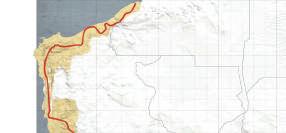





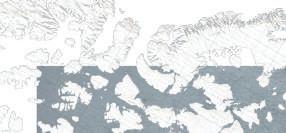


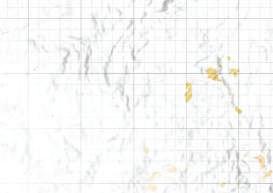





from the world park project showing how the concept works. (Concept: Richard Weller,Graphic design by Madeleine Ghillany-Lehar)
from the






















project showing how the






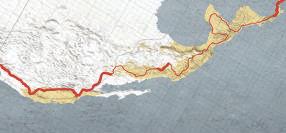

in
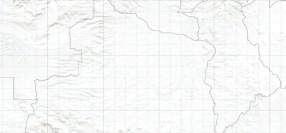


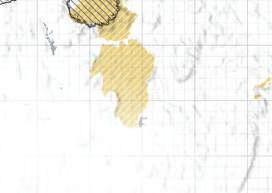
(Concept: Richard Weller,Graphic design by Madeleine Ghillany-Lehar)







CASE STUDY THE WORLD PARK
WORKS HOW IT HOTSPOT NATION RESTORATION PROJECT CAMPSITE PROTECTED AREA PROTECTED AREA WPP RESTORATION NEW TRAIL NEW CAMPSITE The World Park’s trails link together many of the world’s existing protected areas in biodiversity hotspots (regions where irreplaceable species are threatened with extinction). With campsites every 20 kilometers, the trails provide recreational access to these landscapes and also serve as catalysts for ecological restoration projects along the entire route. THE WORLD PARK REPORT CASE STUDY WALES ALASKA UNITED STATES OF AMERICA CANADA MEXICO GUATEMALA / BELIZE EL SALVADOR HONDURAS NICARAGUA COSTA RICA PANAMA / COLOMBIA / ECUADOR PERU CHILE / ARGENTINA15 24,000 km 5 CALIFORNIA FLORISTIC PROVINCE MESO-AMERICA TUMBES-CHOCO MAGDALENA TROPICAL ANDES CHILEAN WINTER RAINFALL VALDIVIAN FORESTS HOTSPOTS 15,000 MILES // 48,000 km RESTORED LAND NATIONS 500km1000km 2000km HOTSPOT ZONE PAT-ASKA USHUAIA ARGENTINA THE TRAIL THE AUS-ROC TRAIL
TARFAYA MOROCCO
HOBART TASMANIA MOROCCO SPAIN / FRANCE ITALY/ GREECE TURKEY GEORGIA RUSSIA/ TURKMENISTAN AZERBAIJAN / IRAN AFGHANISTAN UZBEKISTAN/ TAJIKISTAN/ PAKISTAN / NEPAL/ INDIA MYANMAR/ THAILAND MALAYSIA SINGAPORE INDONESIA / AUSTRALIA 23 38,000 km 7 MEDITERRANEAN BASIN / IRANO-ANATOLIA/ MOUNTAINS OF CENTRAL ASIA HIMALAYA/ INDO-BURMA / SUNDALAND FORESTS OF EASTERN AUSTRALIA HOTSPOTS 23,500 MILES // 76,000 km RESTORED LAND NATIONS 500km1000km 2000km HOTSPOT ZONE NEW TRAIL EXISTING TRAIL FERRY TUR-IBIA THE TRAIL LUDERITZ NAMIBIA 250km500km 1000km HOTSPOT ZONE NAMIBIA REPUBLIC OF SOUTH AFRICA LESOTHO / MOZAMBIQUE MALAWI TANZANIA UGANDA RWANDA BURUNDI/ DEMOCRATIC REPUBLIC OF CONGO KENYA / SOMALIA ETHIOPIA ERITREA / DJBOUTI EGYPT ISRAEL LEBANON SYRIA TURKEY 20 19,500 km 7 SUCCULENT KAROO / CAPE FLORISTIC REGION MAPUTALAND PONDALAND ALBANY / COASTAL FORESTS HORN OF AFRICA EASTERN AFROMONTANE MEDITERRANEAN BASIN DÖRTYOL TURKEY HOTSPOTS 12,000 MILES // 39,000 km RESTORED LAND NATIONS
case
exemplifies
trails and paths
biodiversity loss. 26 27 figure 13 figure
figure 14 figure
world park
concept works
multiple countries.
HABITAT HABITAT CORE CONNECTORS

HABITAT CORES maps have been overlayed. species travel?


























capes should be altered the habitat connector map and the habitat core Where can specific streets be selected in order to provide optimal human and



























Street
the







have been

Where can specific streets be selected in order to provide




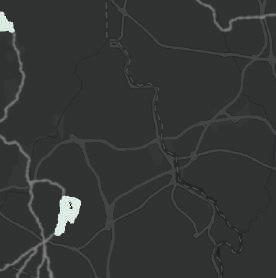













human and


































travel? CAN THESE ALREADY PEDESTRIANIZED STREETS BE OVER LAPPED WITH HABITAT CORE AND HABITAT CONNECTOR DATA TO DETERMINE IF THESE EXISTING RE PURPOSED STREETS ALIGN AS NEW THROUGH WAY HABITAT CONNECTORS?
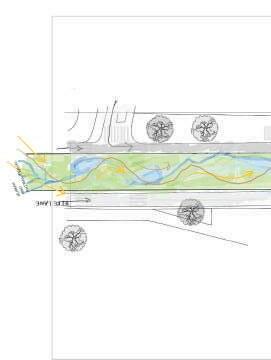
Street
Street
14th street + 34th
73rd
+ 80th
figure 15 this map shows habitat core and habitat connector data from esri overlayed through GIS Green Infrastructure Center Inc., Esri In order to figure out what street scapes should be altered the habitat connector map and
habitat core maps
overlapped.
optimal
species
figure 16 Streetscape sketches Meaghan Kelly
28 29 CONNECTING
HUMAN MODIFIED SURFACES

URBAN SPRAWL
New York City alone contains more people than Wyoming, Montana, Idaho, both Dakotas, Nebraska, and New Mexico combined.

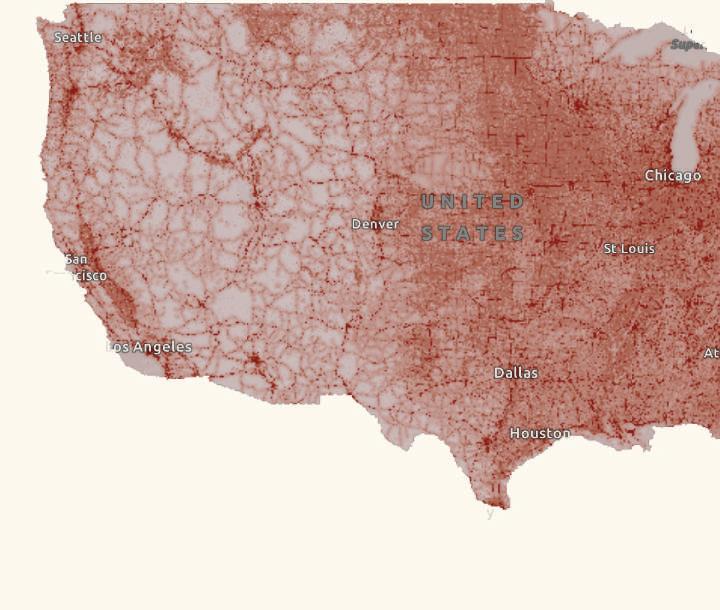
New York City’s population density is three times that of Los Angeles.
New York City is more populated than Mongolia, Greenland, and Norway combined.
CASE STUDY:
for the END of

The mapping and research pertaining to the Hotspot Cities has been conducted by Nanxi Dong, Zuzanna Drozdz with assistance from Rong Cong and Joshua Ketchum.

Karen C. Seto, Burak Güneralp, & Lucy R. Hutyra, “Global Forecasts of Urban Expansion to 2030 and Direct Impacts on Biodiversity and Carbon Pools,” Proceedings of the National Academy of Science of the United States 109, no. 40 (2012): 16083-16088.

These are based on the IUCN’s data for Terrestrial Mammals, Amphibians, Birds, Reptiles and Freshwater Groups. See: The IUCN Red List of Threatened Species, http://www.iucnredlist.org (accessed June 1, 2016) and the Global Land Cover Facility, “MODIS Land Cover,” http://glcf.umd.edu/data/lc/ (accessed August 4, 2017)


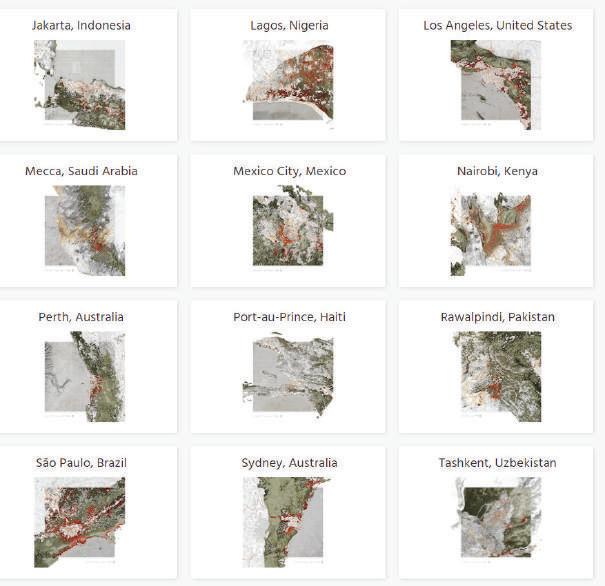


HOTSPOT CITIES CASE STUDY
ATLAS
the WORLD MODIFIED 3031
POPULATION figure 19 figure 18figure 17 Figure from hotspot cities project displaying sprawl in relation to biodiversity loss figure 18 human modified surfaces map from Green Infrastructure Center Inc., Esri This is the citation for maps on left figure 18
AUDIENCE
City legislators:
(Success in other parts of the world in re-wilding cities is rooted in a change in legislature)

Urban Planners
Youth: Inheritors of the planet (it is important to encourage investment in landscape in the generation who will ultimate-ly be required to deal with the damage our ancestors have done)
HABITAT
SINGAPORE 2030 GREEN PLAN
some key targets


Greener Infrastructure and Buildings
2025 targets:
WHY DO WE NEED HABITAT AND A MEANS FOR INTERSPECIES TRAVEL DIRECTLY IN THE CITY?


Reduce energy consumption of desalination process from current 3.5kWh/m3 to 2kWh/m3 Singapore’s first integrated waste and used water treatment facility to be 100% energy self-sufficient (Tuas Nexus) 2030 targets:
Green 80% of Singapore’s buildings (by Gross Floor Area) by 2030


MORE PEOPLE LIVE IN CITIES - HOW DO YOU GET PEOPLE TO CARE ABOUT SOMETHING THEY HAVE NEVER ACTUALLY SEEN WITH THEIR OWN EYES, SOMETHING THAT DOES NOT DIRECTLY AFFECT THEM.
19
The above map shows habitat cores in Singapore and the below map shows the previously shown cores near Manhattan Green Infrastructure Center Inc., Esri


PARKS
2026 target:

Develop over 130 ha of new parks, and enhance around 170 ha of existing parks with more lush vegetation and natural landscapes. 2030 targets:
Double our annual tree planting rate between 2020 and 2030, to plant 1 million more trees across Singapore
Increase nature parks’ land area by over 50% from 2020 baseline
Every household will be within a 10-minute walk from a park 2035 target:
Add 1000 ha of green spaces
Green Commutes 2030 targets:
Achieve 75% mass public transport (i.e. rail and bus) peak-period modal share
Expand rail network from around 230km today to 360km by early 2030s
80% of new buildings (by Gross Floor Area) to be SLE buildings from 2030 Best-in-class green buildings to see an 80% improvement in energy efficiency (over 2005 levels) by 2030 Long-term target: Reduce desalination energy further to 1kWh/m3
Sustainable Towns and Districts 2030 target:
Reduce energy consumption in existing HDB towns by 15% Cleaner-energy Vehicles 2025 targets:
New registrations of diesel cars and taxis to cease from 2025
7 EV-Ready Towns with chargers at all HDB carparks by 2025 2030 targets:
All new car and taxi registrations to be of cleaner-energy models from 2030 33 Target 60,000 charging points nationwide by 2030, including 40,000 in public carparks and 20,000 in private premises
Triple cycling paths to 1,320km from 460km in 2020 W
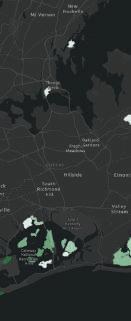
Strengthen Green Efforts in Schools 2030 targets:
Achieve a two-thirds reduction of net carbon emissions from the schools sector
At least 20% of schools to be carbon neutral
“Overview,” Singapore Green Plan 2030, accessed May 12, 2022, https://www.greenplan. gov.sg/key-focus-areas/overview.
SINGAPORE CHANNELING THE GARDEN CITY
SINGAPORE
CORES NYC HABITAT CORES POPULATION 1.69 million POPULATION 5.7 million Similar issues of density per square foot MANHATTAN SINGAPORE
32
figure
figure 19
NEW YORK CITIES OPEN STREETS PROGRAM

New York City’s Open Streets program transforms streets into public space open to all. These transformations allow for a range of activities that promote economic development, support schools, and provide new ways for New Yorkers to enjoy cultural programming and build community.
acres of pavement dedicated to motor vehicles and








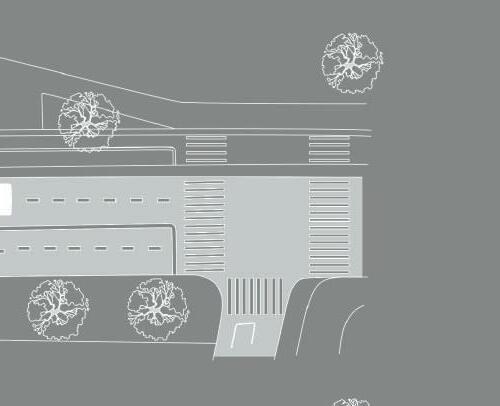
970 acres designated for off street parking
Manhattan
covers low-









































23rd
Close to 4X the size of









A CITY WITHOUT CARS
HOW CARS/ PEOPLE/ BIKES USE THE STREETSCAPE 50 CARS 50 PEOPLE IN 1 BUS 50 BICYCLES 50 PEOPLE parking 2450
another
lots and garages parking combined it
er
up to
street
central park almost 5 central parks worth of parking 34 35 figure 20 parking diagrams, Meaghan Kelly figure 21
Parking Diagrams of the Street scape, Meaghan Kelly
SECTION 7DESIGN OUTCOMES
MEAGHAN KELLY
CONTEXTCASE STUDIES
PRIMARY ADVISOR: JOEL KERNER
36 37
scape








barrierfacade-scape pedestrian bike lanes habitat public transportation roof scape street
underground scape INITIAL CONCEPT SKETCH 38 39 figure 22 Initial concept sketch, Meaghan Kelly
bats
pollinatorsbirds of prey


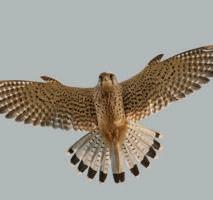
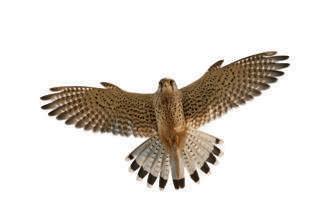
ROOF-SCAPE
bats




birds

bugs
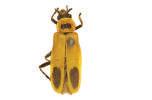
plants
DESIGN METHODOLOGY
Define scope through the surfaces of the facade street and roof.
Determine which species are better suited to each surface.



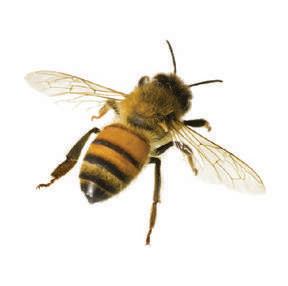

Explore life cycle relationship of each surface in relationship to one another.
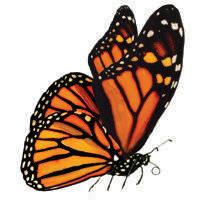
Design each surface to suit the needs of focus species


predators - micro wetlands - elevated walking paths

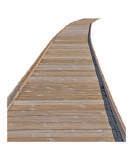


small
plants feed the bugs feed the birds animal dung becomes fertilizer pollinators aid in the groth of the rewilded streetscape
sections of facade designed for each species birds of prey aid in pest controllower rat/ rodent population small predators for additional pest control
FACADE-SCAPE STREET-SCAPE
40 41 figure 23 Design scope sketch Meaghan Kelly
FOCUS
BENEFICIAL ECOSYSTEM SERVICES?

POLLINATORS AND PEST PREDATORS

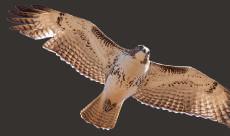










BEGIN WITH




AND UTILIZATION OF



POLLINATORS PEST PREDATORS
WHY WE NEED POLLINATORS?
Worldwide, pollinators are necessary for the reproduction of over 85% of the earth’s flowering plants, including more than 2/3 of the world’s food crop species.
Pollinators are also keystone species, meaning a species on which other species in an ecosystem largely depend. Fruits and seeds derived from insect pollination are a major part of the diet of approximately 25% of all birds and of many mammals worldwide.

Although birds, bats, and some reptiles can provide pollination services, the vast majority of plants are pollinated by insects. And, while bees are the most important pollinators from this group, flies, wasps, beetles, moths, and butterflies are also important for the pollination of many species of plants.

“Wildlife in New York City,” Learning Hub: Wildlife in New York City Parks : NYC Parks, accessed May 12, 2022, https://www.nycgovparks.org/learn/wildlife-in-new-york-city.








CHALLENGES FACED BY NYC POLLINATORS






Unfortunately, in many places, the essential service of pollination is at risk from habitat loss and the loss of native host plants, pesticide use, and introduced insect species and diseases.

SPECIES WHAT SPECIES PROVIDE
CAN WE
THE INTRODUCTION
THESE SPECIES AND THEN SLOWLY REINTRODUCE SPECIES THE GENERAL PUBLIC WOULD BE LESS LIKELY TO IMMEDIATLEY WARM TO.
ruby-throated
hummingbird (Archilochus colubris)
big
brown bats
tri-colored
bats
Canadian Tiger Swallowtail Aphrodite Fritillary American Lady Pipevine Swallowtail Monarch Mourning Cloak
White M Hairstreak
Tawny Emperor Falcate Orangetip Common Wood Nymph Common Buckeye Goldenrod Soldier Beetle
Brown Belted Bumble Bee
Ligated
Furrow Bees aka Mining or Sweat Bees
Leaf
Cutter Beesx
bald eagle
great horned owl red-tailed Hawk
American Robin red fox
42
43 Figure 24 Pollinator and Pest Predator Diagram, Meaghan Kelly
waste collection
pollinatorsbirds of prey bats
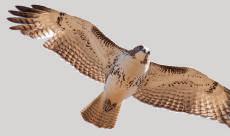
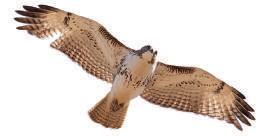









DESIGN NEEDS
HABITAT NEEDS
Nocturnal Winter hibernation - insulated Roost in slat like cavities Maternity colonies


DIET Herbivore and insectivore

ECOLOGICAL NICHE
Big brown bats play a very important role in their ecosystem. They are significant predators of agricultural pests which makes them quite helpful to farmers. A 1995 study found that, per year, a colony of 150 Big brown bats in Indiana or Illinois con-sumes 600,000 cucumber beetles, 194,000 scarab beetles, 158,000 leafhopper, and 335,000 shield bugs - all of which cause serious agricultural damage
animalia
HABITAT NEEDS
warm summer breeding grounds in north Amerxica milkweed plants
DIET Herbivore
ECOLOGICAL NICHE
Western monarchs have declined by more than 99 percent since the 1980s. Eastern monarchs have declined by an estimated 80 percent.







The disappearance of milkweed is a major reason for their population decline. Milkweed, which is the only place monarchs will lay their eggs and the only food caterpillars will eat, used to grow in and around agricultural crops. The systematic removal of milkweed from fields in recent years, as well as increased use of herbicides and mowing alongside roads and ditches, has significantly reduced the amount of milkweed available. They are also very sensitive to temperature changes which makes climate change a pressing issue for monarchs. -animalia
HABITAT NEEDS
nest in high elevation must have high spacious perches for large nests
DIET
opportunistic generalists, but in North America, they are most often predators of small mammals such as rodents


ECOLOGICAL NICHE
Red tailed Hawks are no longer on the endangered list, but they are still protected by the Migratory Bird Act. They’ve made quite a comeback over the past few years and you can see them sitting on top of telephone poles, billboards, fence posts, and in trees while driving in rural areas. In fact, there are quite a large number of urban hawks now, which is good for bird lovers, but sad because it comes from us developing their natural habitat.
HABITAT NEEDS
warm housing small tubular crevices
south facing/ unshaded attracted to blue flowers
DIET
Cirsium (Thistle) Asclepias (Milkweed) Helianthus (Sunflowers)
ECOLOGICAL NICHE













Bumble bee populations are doing poorly worldwide, with declines reported in North and South America, Asia, and Europe. A combination of climate change, pesticides, mono culture planting, habitat loss and fragmentation, competition, and disease transmission are responsible.




birds bats species controllower rat/ rodent population ROOF-SCAPE FACADE-SCAPE ROOF LIFE CYCLE ANALYSIS
Canadian Tiger Swallowtail
Aphrodite Fritillary
American Lady Pipevine Swallowtail
MonarchMourning Cloak
White M Hairstreak
Tawny EmperorFalcate Orangetip
Common Wood Nymph
Common Buckeye
big brown batstri-colored bats
red-tailed Hawk
bald eagle great horned owl
American Robin
Pollinator/
Pest predator Pollinator PollinatorPest predator
Brown Belted Bumble Bee
Ligated Furrow Bees
aka Mining or Sweat Bees
44 45Figure 25 Roof life cycle Analysis Diagram, Meaghan Kelly
“Big Brown Bat,” Big Brown Bat - Facts, Diet, Habitat & Pictures on Animalia.bio, accessed May 12, 2022, https://animalia.bio/big-brown-bat. “Monarch Butterfly,” Monarch butterfly Facts, Diet, Habitat & Pictures on Animalia.bio, accessed May 12, 2022, https:// animalia.bio/big-monarch-butterfly.
-animalia “Red tailed hawk,” Red tailed hawk - Facts, Diet, Habitat & Pictures on Animalia.bio, accessed May 12, 2022, https://animalia.bio/Red tailed hawk.
animalia “Brown belted bee,”Brown belted bee Facts, Diet, Habitat & Pictures on Animalia.bio, accessed May 12, 2022, https:// animalia.bio/Brown belted bee.
Components to be placed on roof tops






Each component consists of a series habitats for specific species that operate together in a closed loop life cycle







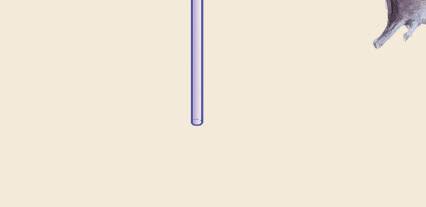



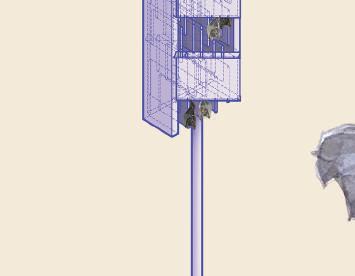







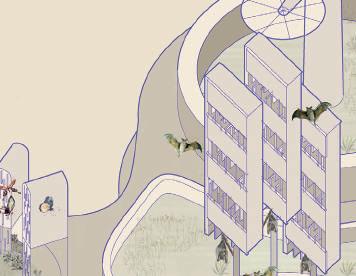
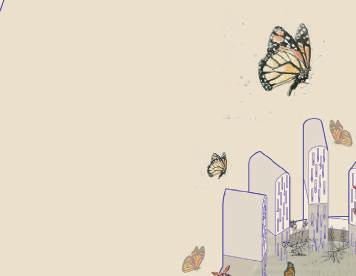


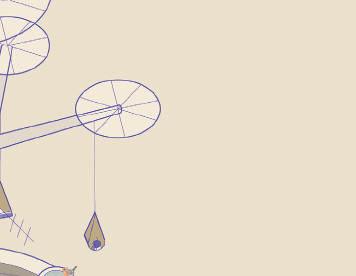


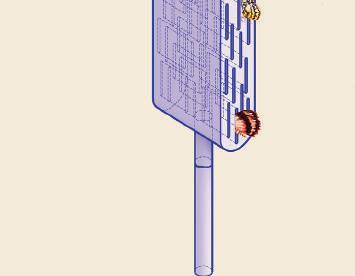

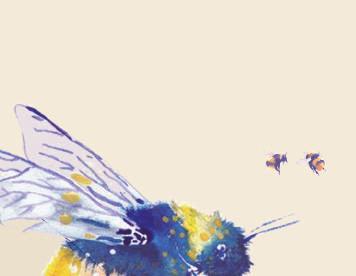


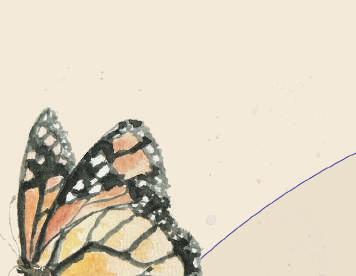
46 47
Figure 26
Roof Axon Drawing Meaghan Kelly


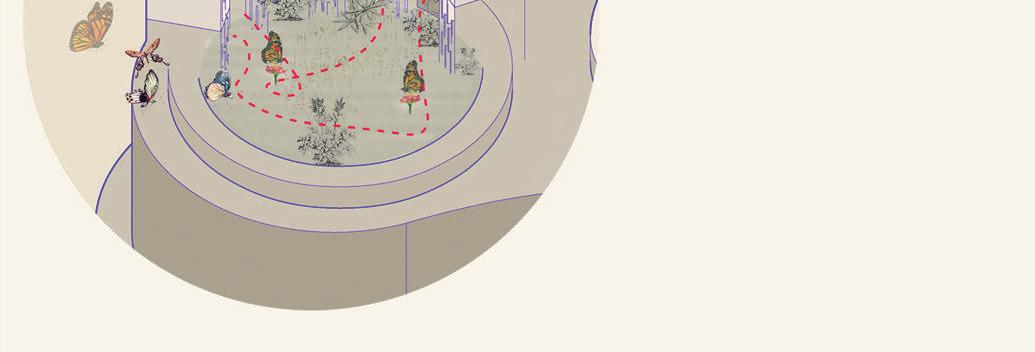




48 49
each specific habitat is designed per the needs of the species as well as their size
Figure 27
Roof Axon Use Diagram , Meaghan Kelly






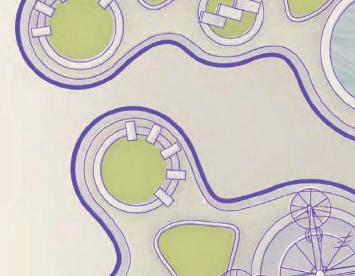
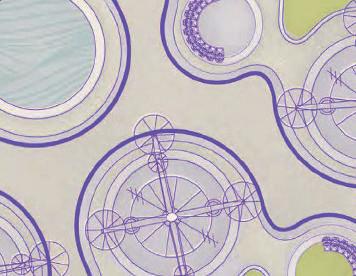






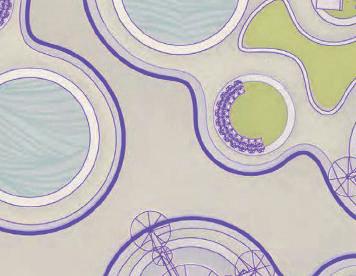
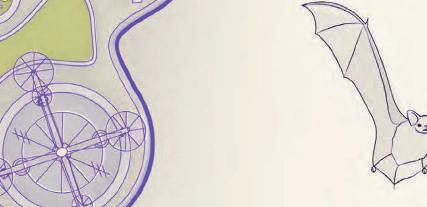



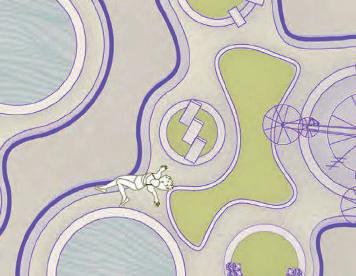

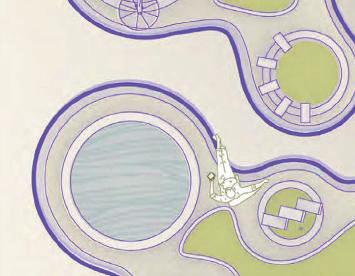
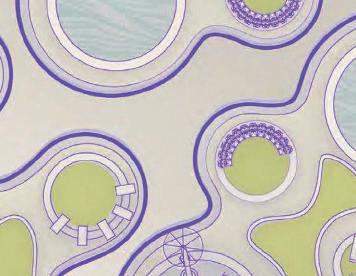






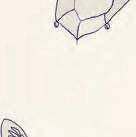










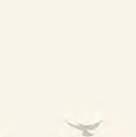





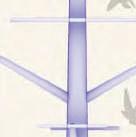







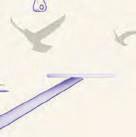















































50 51
The units can be placed in order to foster interspecies travel from habitat unit to unit
How do humans occupy the space?
Figure 28
Site Plan, Elevation, Food chain Drawing Meaghan Kelly
sited on lower fourteenth streetthis area had been selected as a part of the nyc open streets program




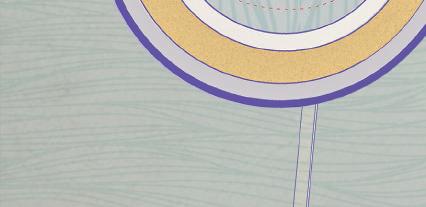
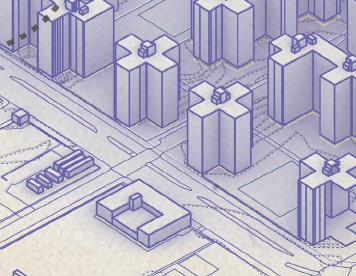

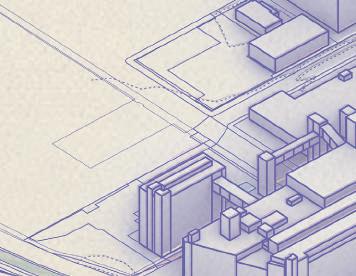
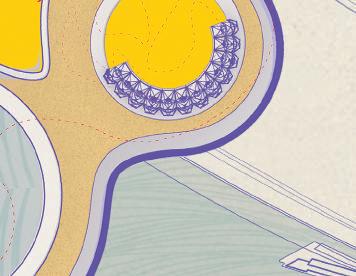
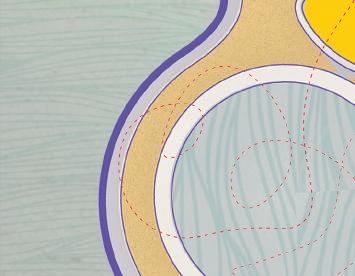
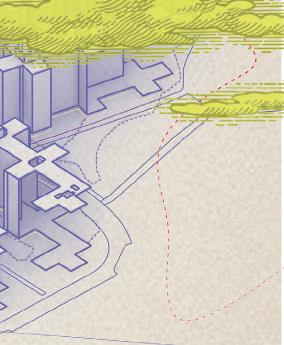
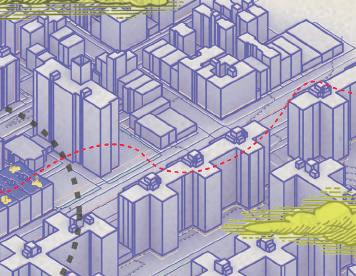
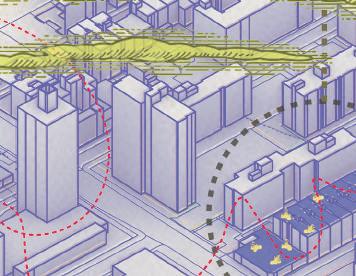



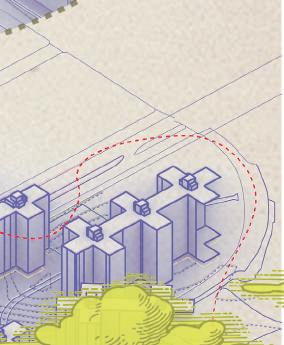
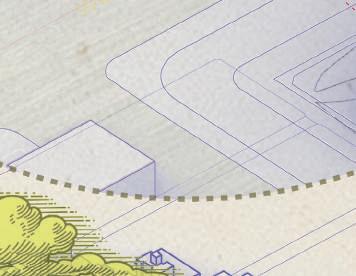
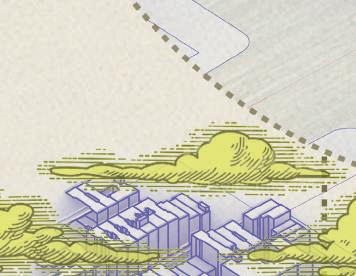

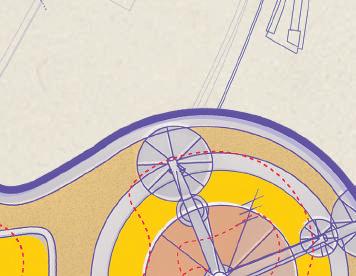
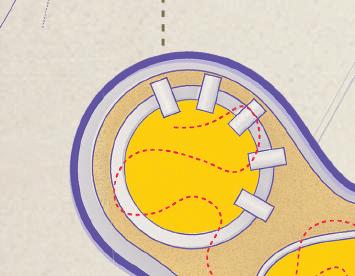

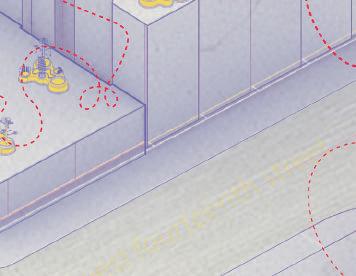
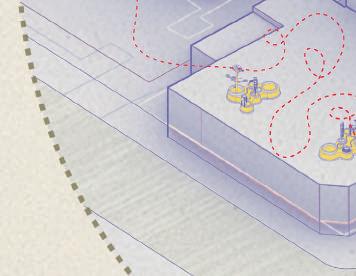


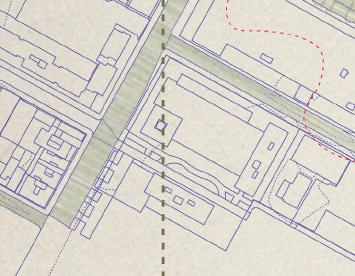
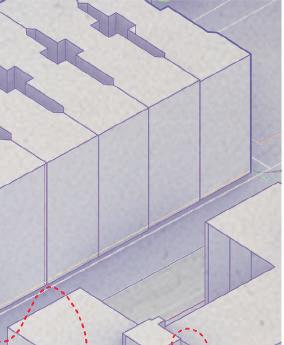





52 53
Figure 29
Site Axons, Meaghan Kelly
bats
birds
DESIGN




bugs

dung becomes fertilizer
plants
HABITAT NEEDS
Nocturnal
DIET
HABITAT NEEDS
HABITAT NEEDS
hibernation - insulated
in
like





colonies

Herbivore and insectivore

ECOLOGICAL NICHE
Big brown bats play a very important role in their ecosystem. They are significant predators of agricultural pests which makes them quite beneficial to farmers. A 1995 study found that, per year, a colony of 150 Big brown bats in Indiana or Illinois consumes 600,000 cucumber beetles, 194,000 scarab beetles, 158,000 leaf hoppers, and 335,000 shield bugs - all of which cause serious agricultural damage



plants feed the bugs feed the birds
warm summer breeding grounds in north America attracted to red flowers


Herbivore
ECOLOGICAL NICHE
Hummingbirds feed frequently to support their high-energy nutritional needs. Plant flowers that attract hummingbirds with abundant nectar and specialized blooms for these birds to feed, and minimize the use of insecticides so there are plenty of small insects available. Adding colorful hummingbird feeders also gives the birds a rich, reliable source of supplemental food.



nest in high elevation must have high spacious perches for large nests

DIET
The flowers, besides providing nectar, are also a meeting place for finding mates. They do no long-term damage to the plants and do not bite or sting.



ECOLOGICAL NICHE





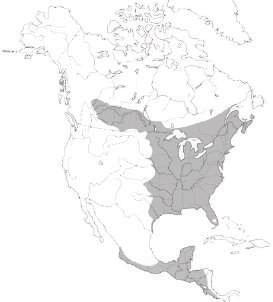
birds of prey aid in pest control


Beetles were among the first insects to evolve to visit flowers. They are especially important pollinators for ancient species such as magnolias and spicebush. Beetles will chew through petals and other floral parts to get to the nectar within. They often defecate within flowers, earning them the nickname “mess and soil” pollinators. While pollination by beetle is less common in New York City than by other insects, beetles do pollinate native magnolias, pond lilies, goldenrod, and spirea.
NECTAR - hummingbirds

lupine California fuchsia mimulus monkey flower monard featuring pink, red or purple flowers cardinal climber, Ipomoea sloteri
NECTAR - bees salvia Russian sage catnip wisteria sea holly eryngium penstemon
California fuchsia verbena and lamb’s ear stachys
rosemary basil
calamint lavender Vitex agnus-castu chaste tree
small predators -micro wetlands


pollinatorsbirds
bats
animal
sections of facade designed for each species
lower ROOF-SCAPE FACADE-SCAPE STREET-SCAPE
Ruby-Throated Hummingbird
Rufous
Hummingbird
big
brown
batstri-colored bats Goldenrod
Soldier
Beetle
NEEDS Pollinator/ Pest predator Feed plants
Winter
Roost
slat
cavities Maternity
Facts, Diet, Habitat & Pictures on Animalia.bio, accessed May 12, 2022, https://animalia.bio
DIET
Facts,
Diet, Habitat & Pictures on Animalia.bio, accessed May 12, 2022, https://animalia.bio
Facts, Diet, Habitat & Pictures on Animalia.bio,
FACADE LIFE CYCLE ANALYSIS
Pollinator/ Pest predator Pollinator
Milkweednectar producing plants including yellow composites Queen Anne’s lace milkweed rattlesnake master late-summer accessed May 12, 2022, https://animalia.bio 54 55 Figure 30
Facade Life Cycle Analysis, Meaghan Kelly

56 57 Figure 31
Facade
Full Section Meaghan Kelly
PROPOSED






32 current and proposed street Diagrams , Meaghan Kelly





















HUMAN TRAVEL
ANIMAL TRAVEL
REWILDED STREETSCAPE

wilded street scape sketches, Meaghan











barrier barrier pedestrian automobilesbike lanes pedestrian bike lanes habitat public transportation
NORMAL STREETSCAPE
SKETCH PROPOSAL
58 59 CURRENT
figure
illustration 7 illustration 8 illustration 9 figure 33 animal travel section, Meaghan Kelly figure 34 re
Kelly

60 61 Figure 35 Street Full Section Meaghan Kelly
WORKS CITED AND FOR FURTHER READING
• “10 Benefits of Creating Good Public Spaces.” Accessed December 13, 2021. https://www.pps.org/article/10benefits
• “10 Best Animal Architects and Their Constructions.” Accessed November 13, 2021. https://www.wonderslist.com/10 best animal architects constructions/
• “14 Patterns of Biophilic Design,” September 12, 2014. http://www.terrapinbrightgreen.com/reports/14 patterns of biophilic design/
• “AFEW - Hotspot Cities.” Accessed March 17, 2022. http://atlas for the end of the world.com/hotspot_cities_main.html
• “Ants of the Prairie › 13. Living Among Pests.” Accessed April 21, 2022. http://www.antsoftheprairie.com/?page_id=1589
• “Ants of the Prairie › Architecture.” Accessed Apri 20, 2022. http://www.antsoftheprairie.com/
• “ArcGIS - Recent Conditions in Air Quality (PM2.5).” Accessed February 16, 2022. https://www.arcgis.com/home/webmap/viewer.html?layers=8dcf5d4e124f480fa8c529fbe25ba04e
• “Architecture and Biodiversity – Designing a New Urban Ecosystem | FAIRE 2017 | Projects.” Accessed April 20, 2022. https://www.faireparis.com/en/projets/faire 2017/architecture and biodiversity designing-a-new urban-ecosystem-1297.html
• “Big Brown Bat - Facts, Diet, Habitat & Pictures on Animalia.Bio.” Accessed April 28, 2022. https://animalia.bio/big brown bat
• “Biomimicry or Biomimetic Architecture – NEWTONS DESIGN.” Accessed November 13, 2021. https://thenewtonsdesign.com/biomimicry or biomimetic architecture/
• “Biophilia, the Future of Architecture | Matthias Olt | TEDxSeattle - Bing Video.” Accessed February 3, 2022. https://www.bing.com/videos/search?q=BIOPHILIA+ARCHITECTURE&view=detail&mid=AB8E7CC3B2F350F50ACFAB8E7CC3B2F350F50A
CF&FORM=VIRE
• “Bird, Pollinator, & Wildlife Habitat Not Just for National Parks Anymore. (U.S. National Park Service).” Accessed April 22, 2022. https://www.nps.gov/articles/bird pollinator wildlife habitat not just for national parks anymore.htm.
• “Can ‘Rewilding’ Land Help Address Climate Change? | Time.” Accessed November 14, 2021. https://time.com/5669025/rewild land europe/
• “Cars All but Banned on One of Manhattan’s Busiest Streets - The New York Times.” Accessed March 22, 2022. https://www.nytimes.com/2019/10/03/nyregion/car ban 14th street manhattan.html?msclkid=787bce92aa1311ecb303e194b7d2a77f
• “Causes, Effects and Solutions to Urban Sprawl (Migration of a Population) - Conserve Energy Future,” December 30, 2013. https://www.conserve energy future.com/causes and effects of urban sprawl.php
• “Deer, Coyotes in Yards Mean More Planning for Coexistence - The Washington Post.” Accessed November 15, 2021. https://www.washingtonpost.com/science/bats insects coyotes other wildlife-make-cities their homes urban commuities are encouraging this/2020/03/20/6af40ac0 62e1 11ea-acca-80c22bbee96f_story.html
• “Facades of Manhattan Apartment Buildings from the 1902 1915 Period. I: Modes of Failure.” Accessed April 14, 2022. https://ascelibrary.org/doi/epdf/10.1061/%28ASCE%29CF.1943 5509.0001567
• “Green Cities: Rewilding Techniques in Urban Areas.” Accessed November 14, 2021. https://www.cnbc.com/green cities rewilding techniques in urban areas/
• “Green Spaces in Cities Can Help People Live Longer,” December 2, 2019. https://www.medicalnewstoday.com/articles/327177
• “Greener Places.” Accessed November 14, 2021. http://www.governmentarchitect.nsw.gov.au/policies/greener places
• “Learn about I Tree i Tree.” Accessed November 14, 2021. https://www.itreetools.org/
• “Learning Hub: Wildlife in New York City Parks : NYC Parks.” Accessed April 26, 2022. https://www.nycgovparks.org/learn/wildlife in new york city
• “MAP: See What Manhattan Looked Like in 1609 - Midtown - New York - DNAinfo.” Accessed February 17, 2022.
• “Mapping How Urban Sprawl Will Clash With Biodiversity - Bloomberg.” Accessed March 17, 2022. https://www.bloomberg.com/news/articles/2018 02 16/mapping how urban sprawl will clash-with biodiversity?msclkid=d9466079a60111eca8ed59dbb37dd0ca
• “New Natures: New Middles_UB.” Accessed April 20, 2022. https://newnaturesnewmiddlesub.cargo.site/
• “NYC Parks’ Urban Wildlife Calendar: When and Where to See Wildlife in NYC : NYC Parks.” Accessed February 11, 2022. https://www.nycgovparks.org/programs/wildlife management/calendar
• “PAU | N.Y.C. | Not Your Car Why We the People Must ‘Dominate the Streets.’” Accessed March 22, 2022. https://pau.studio/what/nyc/
• “Pollinators in New York City Parks: Bees, Butterflies, and Beyond : NYC Parks.” Accessed April 21, 2022. https://www.nycgovparks.org/learn/wildlife in new york city/pollinators
• “Richness of Imperiled Species in the United States - Overview.” Accessed March 22, 2022. https://www.arcgis.com/home/item.html?id=6e90cefddb634e6a949838e7efff55fb
• “Story Map Journal.” Accessed February 16, 2022. https://nation.maps.arcgis.com/apps/MapJournal/index.html?appid=516cbf991a49466a96c00a7bb51eab20
• “The Biodiverse City.” Accessed December 13, 2021. https://www.stockholmresilience.org/research/research news/2012 06 08 the biodiverse city.html
• “The Biodiversity of Singapore.” Accessed February 3, 2022. https://www.singapore.biodiversity.online/
• “The Welikia Project » How It All Began.” Accessed March 22, 2022. https://welikia.org/about/how it all began/
• “Uplift House Bergen Street Studio.” Accessed March 8, 2022. https://bergenstreetstudio.com/project/uplift house/
• “Urban Butterfly Monitor Scheme | CREAF.” Accessed November 14, 2021. https://www.creaf.cat/urban butterfly monitor scheme
• “Urban Observatory.” Accessed March 23, 2022.https://www.urbanobservatory.org/compare/index.html?group%3Df4373b6eae144e26a634937269d336ec%26noun%3DPeople%26theme
%3DPopulation%2520Density%26cities%3DNew%2520York%26cities%3DLondon%26cities%3DTokyo%26minLevel%3D8%26level%3D11%2 6maxLevel%3D16%26dualPane%3Dfalse
62 63
• “Urban Rewilding: How Londoners Are Attracting Wildlife to the Capital | Evening Standard.” Accessed November 15, 2021. https://www.standard.co.uk/news/london/urban rewilding how londoners attracing widlife to the capital b964387.html
• “Welikia 1609 Map.” Accessed March 22, 2022. https://welikia.org/m map.php
• “What Are Biodiversity Hostpots? Examples Environment Buddy.” Accessed December 13, 2021. https://www.environmentbuddy.com/endangered wildlife/list of biodiversity hotspots examples/
• “What Is and Is Not Biophilic Design? - Metropolis.” Accessed November 15, 2021. https://metropolismag.com/projects/what is and is not biophilic design/
• “What Is Trophic Cascade? Types, Examples | Environment Buddy.” Accessed December 13, 2021. https://www.environmentbuddy.com/endangered wildlife/trophic cascade types examples/
• Above The Noise. Can Wild Animals and Humans Coexist in Cities?, 2021. https://www.youtube.com/watch?v=sE0ebSGDltw
• Ahuja, Riya. “Biomimicry Architecture: A Unique Art Of Mimicking The Design Gesture.” Accessed November 13, 2021. https://thedesigngesture.com/biomimicry architecture/
• ana0cosma. “Architecture for Animals - Arch2O.Com.” Accessed November 13, 2021. https://www.arch2o.com/architecture for animals/
• Answers. “Is a Red Tailed Hawk Endangered?” Accessed April 28, 2022. https://www.answers.com/zoology/Is_a_Red_Tailed_Hawk_endangered
• Ants of the Prairie › 12. Experimental Habitats for New York Rooftops.” Accessed April 20, 2022. http://www.antsoftheprairie.com/?page_id=1480
• ArcGIS StoryMaps. “The Living Land,” May 28, 2021. https://storymaps.arcgis.com/stories/5b568fa8626e452ab714b7bcec5aff35
• ArcGIS StoryMaps. “Wild Neighbors: Animal Adaptations in Jamaica Bay & Rockaway,” March 14, 2022. https://storymaps.arcgis.com/stories/892c5eecf7144930b9b9b9b8269bddd1
• ArchDaily. “PAU Reimagines New York City Without Cars,” July 13, 2020.
• ArchDaily. “The Facts about Architecture and Climate Change,” August 18, 2021. https://www.archdaily.com/931240/the facts about architecture and climate change
• ArchDaily. “What Is Biomimetic Architecture?,” December 31, 2020. https://www.archdaily.com/954004/what is biomimetic-architecture
• Architizer. “PiM.Studio Architects,” June 11, 2019. https://architizer.com/firms/pim studio/
• BBC Reel. Could Rewilding Be a Natural Solution to Urban Stress? Video with George Monbiot - BBC REEL 2020. https://www.youtube.com/watch?v=aUCaLSL2bkw
• Bloomberg.com. “Mapping the Native Americans and Wildlife of Old New York,” October 1, 2015. https://www.bloomberg.com/news/articles/2015 10 01/mapping the wildlife and peoples of manhattan in 1609
• Burgen Stephen. “Bat Boxes, ‘greened’ Streets and Bug Hotels: Barcelona Embraces Its Wild Side.” The Guardian, January 31, 2021, sec. Environment. https://www.theguardian.com/environment/2021/jan/31/bat boxes greened streets and-insect-hotels barcelona embraces its wild side aoe
• Chan, Lena, Geoffrey Davison, and Cheryl Chia. “Biodiversity Conservation in Singapore.” CITYGREEN 01, no. 01 (2010): 60. https://doi.org/10.3850/S2382581210010112
• CityLand. “Council Votes to Make Open Streets Program Permanent,” May 10, 2021. https://www.citylandnyc.org/council votes to-make-open streets program permanent/
• CMG Landscape Architecture. “Democratic Public Space,” August 24, 2017. https://www.cmgsite.com/democratic public space/
• Coniferous Forest. “Big Brown Bat,” August 9, 2016. https://www.coniferousforest.com/big brown bat.htm
• Conklin, Emily. “Architecture for Animals – Perkins&Will.” Accessed November 13, 2021. https://perkinswill.com/news/architecture for animals/
• De, Oendrila. “10 Best Animal Architects and Their Constructions.” Wonderslist (blog), November 3, 2014. https://www.wonderslist.com/10 best animal architects constructions/
• EcoWatch. “8 Cities Rewilding Their Urban Spaces,” June 15, 2021. https://www.ecowatch.com/cities rewilding 2653383263.html
• Ensia. “Bringing Nature Back to Cities Is Good for Plants, Animals and Humans.” Accessed November 15, 2021. https://ensia.com/features/nature cities/
• Environment. “Singapore Aims to Be the World’s Greenest City,” February 28, 2017. https://www.nationalgeographic.com/environment/article/green urban landscape cities Singapore
• Facebook, Twitter, and University of Toronto. “What Might Our Cities Look Like Without Cars?” Treehugger. Accessed March 22, 2022. https://www.treehugger.com/what might our cities look like without-cars-5085833
• For More Wonder, Rewild the World | George Monbiot 2013. https://www.youtube.com/watch?v=8rZzHkpyPkc
• Forest Creators. “Miyawaki Method of Afforestation | Miyawaki Tree Planting India.” Accessed December 12, 2021. https://forestcreators.com/miyawaki method/
• Forum, World Economic. “Strategic Intelligence | World Economic Forum.” Stategic Intelligence. Accessed February 16, 2022. https://intelligence.weforum.org
• Heidari, Mozhgan, and Mahmud Rezaei. “Architectural Design Review Based on Animal Architecture and Biogas Productions.” Biosciences, Biotechnology Research Asia 12, no. 3 (n.d.): 2629 38.
• HINTERLANDS. “Considering Non Human Citizenship.” Accessed February 16, 2022. http://www.hinterlands ul.net/considering nonhuman
• HINTERLANDS. “The Biodiverse City.” Accessed February 16, 2022. http://www.hinterlands ul.net/the biodiverse city
• Home Guides SF Gate. “A List of Nectar Rich Flowers.” Accessed May 2, 2022. https://homeguides.sfgate.com/list-nectarrich-flowers 23115.html
• https://nymag.com/intelligencer/2017/12/architect plans new-york-city.html
64 65
• https://www.archdaily.com/943617/pau reimagines new-york-city without-cars
• https://www.dnainfo.com/new york/20150929/midtown/map see what manhattan looked like 1609/
• Information, Plant. “Research Guides: Butterfly Gardens: Native Plants for Common Butterflies.” Accessed April 26, 2022. https://libguides.nybg.org/c.php?g=654973&p=4597781
• INSECT COP. “Why Are Bumble Bees Endangered?,” July 12, 2019. https://insectcop.net/why are bumble bees endangered/
• Institute, The Biomimicry. “The Power of the Biomimicry Design Spiral.” Biomimicry Institute, June 14, 2016. https://biomimicry.org/biomimicrydesign spiral/
• Jagannath, Thejas. “The Importance of Public Spaces.” Interviews and Articles on Art & Public Spaces (blog), June 15, 2021. https://medium.com/interviews and articles on art public spaces/the importance of public spaces 5bb49ba6c000
• Kantsa, Aphrodite, Thomas Tscheulin, Robert R. Junker, Theodora Petanidou, and Stella Kokkini. “Urban Biodiversity Hotspots Wait to Get Discovered: The Example of the City of Ioannina, NW Greece.” Landscape and Urban Planning 120 (December 1, 2013): 129 37. https://doi.org/10.1016/j.landurbplan.2013.08.013
• Kimmelman, Michael. “When Manhattan Was Mannahatta: A Stroll Through the Centuries.” The New York Times May 13, 2020, sec. Arts. https://www.nytimes.com/2020/05/13/arts/design/manhattan virtual tour-virus.html
• Klapperich, Megan. “Urban Sprawl.” ArcGIS StoryMaps, March 14, 2022. https://storymaps.arcgis.com/stories/ad0f131edb1a44a7ba7547990525005b
• KQED. “Should We Make Cities More Inviting to Wildlife?” Accessed November 14, 2021. https://www.kqed.org/education/186960/should we make-cities-more-inviting to wildlife
• Laughing Squid. “An Animated Map Showing Urban Growth in the Five Boroughs of New York City From 1609 to 2019,” March 12, 2019. https://laughingsquid.com/new-york-city urban growth 1609 2019/
• Manjoo, Farhad. “Opinion I’ve Seen a Future Without Cars, and It’s Amazing.” The New York Times, July 9, 2020, sec. Opinion. https://www.nytimes.com/2020/07/09/opinion/sunday/ban-cars-manhattan cities.html
• Materials, ARH 8005: Living. “Urban Public Green Space.” ArcGIS StoryMaps, February 7, 2022. https://storymaps.arcgis.com/stories/0cf0b1a17f4645b6a0560fd7d3b32819
• Mossy Earth. Life On Earth in 2081 According to the Latest IPCC Climate Reports, 2021. https://www.youtube.com/watch?v=V_0GgDFJPUw
• Myles Zhang. “Myles Zhang,” July 25, 2018. https://www.myleszhang.org/here grows new-york-city/
• Nations, United. “Population.” United Nations. United Nations. Accessed May 12, 2022. https://www.un.org/en/global issues/population
• NC State News. “Can Parks Help Cities Fight Crime?,” June 25, 2019. https://news.ncsu.edu/2019/06/can-parks-help fight-crime/
• Nevius, James. “It’s Time to Ban Cars from Manhattan.” Curbed NY, October 3, 2019. https://ny.curbed.com/2019/10/3/20896837/nyc traffic history pedestrian cars
• Newman, Peter. “Biophilic Urbanism: A Case Study on Singapore.” Australian Planner 51, no. 1 (January 2, 2014): 47 65. https://doi.org/10.1080/07293682.2013.790832
• Nicholls, Henry. “Should Cities Be for Animals Too?” The Guardian April 14, 2014, sec. Cities. https://www.theguardian.com/cities/2014/apr/14/cities animals urban environment species
• Nina-Marie Lister: “Design for Diversity: Betwixt Culture and Nature and the Wild Between,” 2022. https://www.youtube.com/watch?v=4Naz7Lmr2po
• NYPL Digital Collections. “New York in 1776, from the Rear of Col. Rutger’s House, East River ; Engr[Raved] by W. G. Jackman.” Accessed March 23, 2022. https://digitalcollections.nypl.org/items/5e66b3e8 de08 d471 e040 e00a180654d7
• Our Path to Rewilding the Planet, 2021. https://www.youtube.com/watch?v=U iih23ZCbM
• Reuters. “Factbox: 10 Facts about Fast Urban Growth on World Cities Day,” October 31, 2016, sec. Emerging Markets. https://www.reuters.com/article/us global cities factbox idUSKBN12V00Q
• Rewild. Restoring Urban Spaces 2021. https://www.youtube.com/watch?v=G4NqhpweE30
• Rewilding Europe. Rewilding Principles, 2021. https://www.youtube.com/watch?v=B_zZsg36pm4
• Rewilding: Nature Cannot Wait, 2021. https://www.youtube.com/watch?v=314zeb OF30
• RIBA Architecture. Rewilding Architecture with Maria Chiara Piccinelli (PiM.Studio Architects) 2021. https://www.youtube.com/watch?v= skvXZASqnU
• Roser, Max. “Future Population Growth.” Our World in Data, May 9, 2013. https://ourworldindata.org/future population growth
• Sasaki. “Internships.” Accessed February 28, 2022. https://www.sasaki.com/internships/
• SCOTT. “Ants of the Prairie › 10. Co Habitat.” Accessed April 21, 2022. http://www.antsoftheprairie.com/?page_id=870
• Singapore Architects Declare Climate & Biodiversity Emergency. “Singapore Architects Declare Climate & Biodiversity Emergency.” Accessed February 3, 2022. https://sg.architectsdeclare.com/
• Slavikova, Sara Popescu. “Sharing Our Cities: The Concept of Urban Rewilding Greentumble,” February 25, 2017. https://greentumble.com/sharing our cities the concept of urban rewilding/
• Society, National Geographic. “Ecosystem.” National Geographic Society, August 15, 2011. http://www.nationalgeographic.org/encyclopedia/ecosystem/
• Souter, Anna. “Run Rewild: Reinstating Nature.” Architectural Review (blog), January 22, 2020. https://www.architectural review.com/essays/books/run-rewild reinstating nature
• Stockwell, Ben. “What Is Urban Rewilding?” Citizen Zoo (blog). Accessed March 22, 2022. https://www.citizenzoo.org/CZ/urbanrewilding/
• Studio Ossidiana. “The Design of the Encounter.” Accessed April 28, 2022. http://www.studio ossidiana.com/the design of the encounter
• Sullivan, Robert. “Island in the Stream.” The New York Times May 22, 2009, sec. Books. https://www.nytimes.com/2009/05/24/books/review/Sullivan t.html
66 67
• Swanson, Carl. “9 Top Architects Share Their Dream Projects to Improve (or Save) New York City.” Intelligencer, December 28, 2017.
• Syracuse Architecture (Syracuse University School of Architecture). Gena Wirth: “Design for Invertebrates,” 2022. https://www.youtube.com/watch?v=6AAlpuMzpBM
• Taft, Dave. “Hummingbirds Are Lovely Loners, Drawn to New York City’s Parks in Fall.” The New York Times, September 17, 2015, sec. New York. https://www.nytimes.com/2015/09/20/nyregion/hummingbirds are lovely loners drawn to new-york-citys-parks in fall.html
• TED. 7 Principles for Building Better Cities Peter Calthorpe, 2017. https://www.youtube.com/watch?v=IFjD3NMv6Kw
• TED-Ed. From the Top of the Food Chain down: Rewilding Our World - George Monbiot, 2014. https://www.youtube.com/watch?v=t3I9gDocYdk
• The Bowery Boys: New York City History. “Land of the Lenape: A Violent Tale of Conquest and Betrayal,” July 24, 2020. https://www.boweryboyshistory.com/2020/07/sad tale lenape original native new-yorkers.html
• The Environmental Blog. “Benefits of Green Spaces in Urban Areas,” August 25, 2017. https://www.theenvironmentalblog.org/2017/08/benefits of green spaces in urban areas/
• The Expanded Environment. “Animal Architecture Awards Announced!” Accessed November 13, 2021. http://www.expandedenvironment.org/animal-architecture-awards announced/
• The New Yorker.
“Https://Www.Newyorker.Com/Online/2007/10/01/Slideshow_071001_maps?Printable=true&epik=dj0yJnU9eC1YOGxYcDdkTGYyZmNadWdE
UEpSWXQzZHk3d3p4Z3kmcD0wJm49d2I5TGszVVE2R0U0WkQtdUk5ZkgxQSZ0PUFBQUFBR0lPS3pZ.” Accessed February 17, 2022. https://www.newyorker.com/online/2007/10/01/slideshow_071001_maps?printable=true&epik=dj0yJnU9eC1YOGxYcDdkTGYyZmNadWdEUEp
SWXQzZHk3d3p4Z3kmcD0wJm49d2I5TGszVVE2R0U0WkQtdUk5ZkgxQSZ0PUFBQUFBR0lPS3pZ
• The Spruce. “Hummingbird Friendly Habitats.” Accessed May 2, 2022. https://www.thespruce.com/hummingbird habitats 386254
• Time. “U.N. Warns We Are Nowhere Close to Averting a Climate Crisis.” Accessed November 15, 2021. https://time.com/5418134/ipcc climate change report 2030-crisis/
• Transportation Alternatives. “Open Streets Forever.” Accessed April 28, 2022. https://www.transalt.org/open streets forever nyc
• True Nature Foundation. “What Is Rewilding?” Accessed March 22, 2022. https://truenaturefoundation.org/what is rewilding/
• UNEP. “‘A City in a Garden’: Singapore’s Journey to Becoming a Biodiversity Model,” July 30, 2018. http://www.unep.org/news and stories/story/city-garden singapores journey becoming biodiversity model
• University, Stanford. “Designing Sustainable Cities.” Stanford News (blog), June 21, 2021. https://news.stanford.edu/2021/06/21/designing sustainable cities/
• vaibhavsharma2612. “How the Map of New York Has Changed in 500 Years.” Accessed March 24, 2022. https://www.arch2o.com/map new york-500 years/
• Vaughan, Adam. “Urban Wildlife: When Animals Go Wild in the City.” The Observer March 8, 2015, sec. Environment. https://www.theguardian.com/environment/2015/mar/08/urban wildlife animals in city
• Welch, Adrian. “Climate and Biodiversity Emergency Singapore.” e architect, November 11, 2020. https://www.e architect.com/singapore/climate and biodiversity emergency singapore
• World Economic Forum. “BiodiverCities by 2030.” Accessed February 16, 2022. https://www.weforum.org/communities/biodivercities by 2030/
• Yale E360. “Ecopsychology: How Immersion in Nature Benefits Your Health.” Accessed November 14, 2021. https://e360.yale.edu/features/ecopsychology how-immersion-in nature benefits your health
• Yale E360. “Urban Nature: How to Foster Biodiversity in World’s Cities.” Accessed November 14, 2021. https://e360.yale.edu/features/urban_nature_how_to_foster_biodiversity_in_worlds_cities
• Yale E360. “Urban Refuge: How Cities Can Help Solve the Biodiversity Crisis.” Accessed February 16, 202 https://e360.yale.edu/features/urban refuge how cities can help solve the-biodiversity-crisis
• YES! Magazine. “Cities Across Europe Are Making Space for Nature.” Accessed November 14, 2021. https://www.yesmagazine.org/environment/2021/02/24/europe cities nature rewild
• Zlotnik, Hania. “An Urban Future Means Growth for All Cities, Not Just Mega Cities.” Quartz. Accessed March 22, 2022. https://qz.com/1381137/an urban future means-growth for all cities not just mega-cities/
68 69
 URBAN REWILDING
MEAGHAN KELLY
SYRACUSE U NIVERSITY S CHOOL O F ARCHITECTURE
URBAN REWILDING
MEAGHAN KELLY
SYRACUSE U NIVERSITY S CHOOL O F ARCHITECTURE


























































































































































































































































































































































































































































































































































 URBAN REWILDING
MEAGHAN KELLY
SYRACUSE U NIVERSITY S CHOOL O F ARCHITECTURE
URBAN REWILDING
MEAGHAN KELLY
SYRACUSE U NIVERSITY S CHOOL O F ARCHITECTURE
